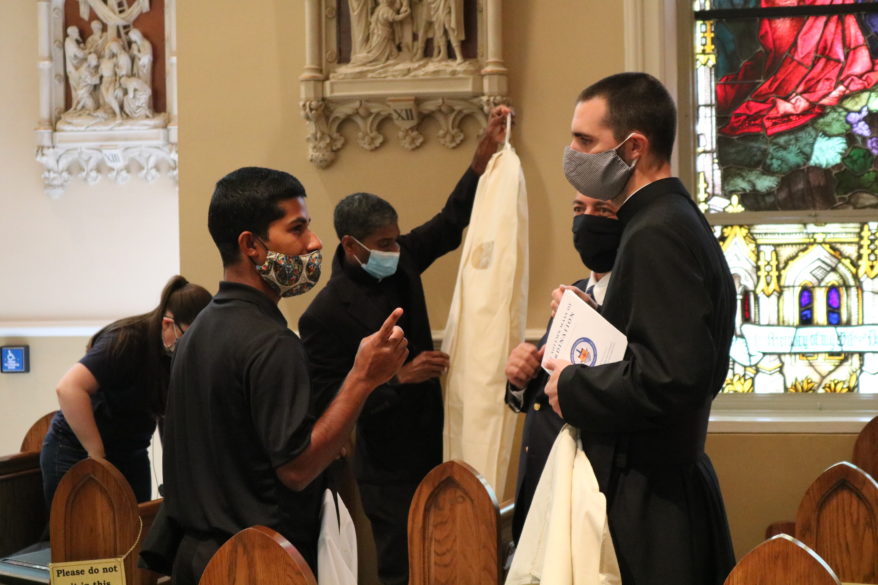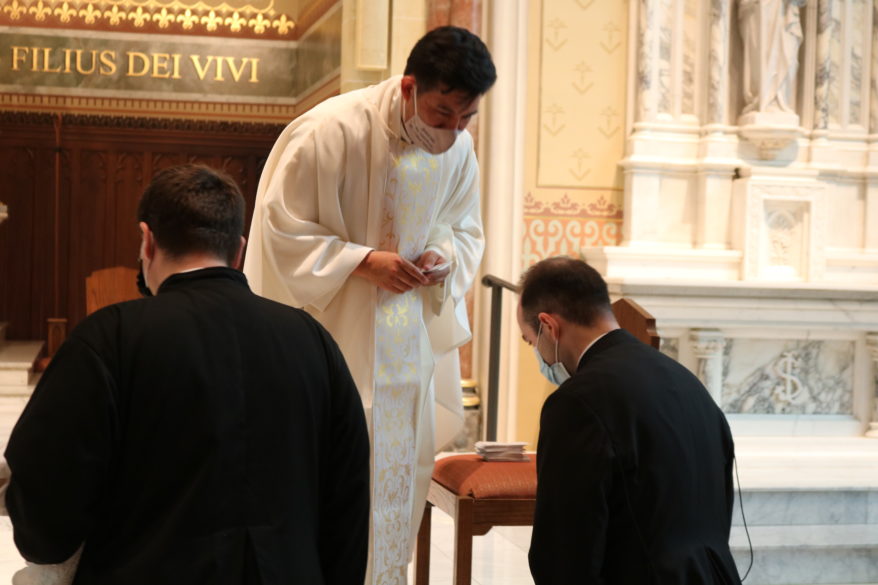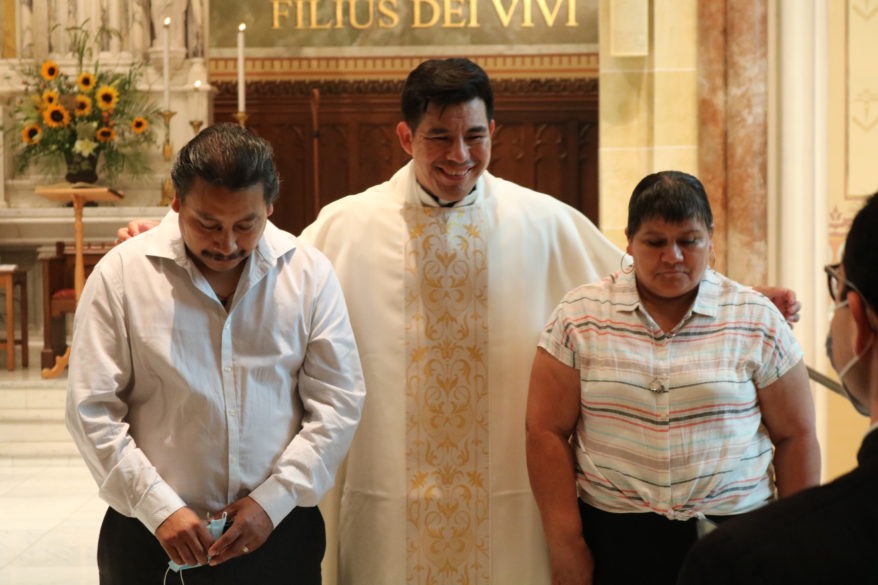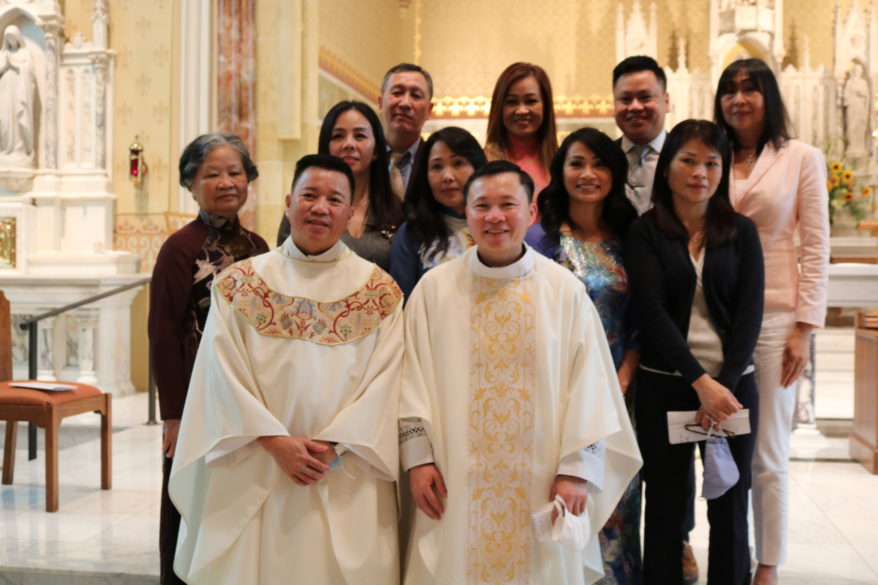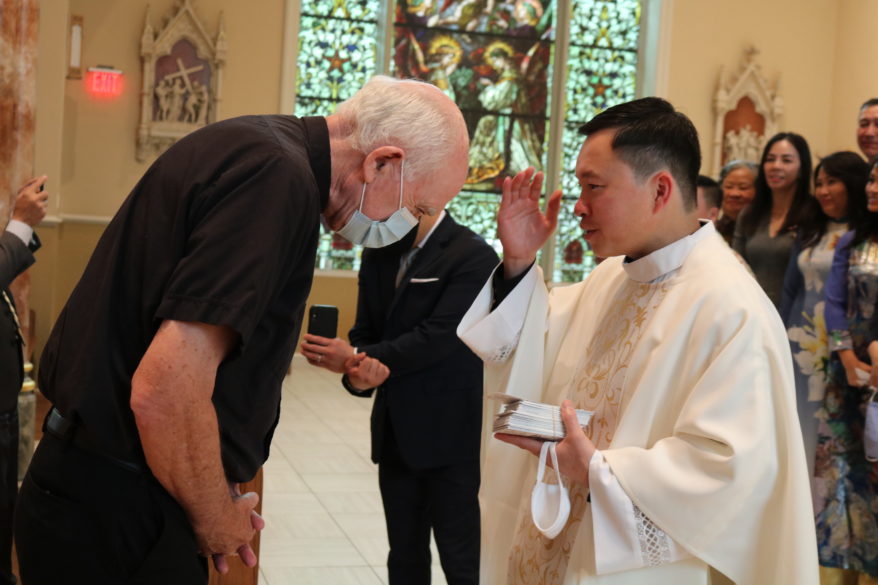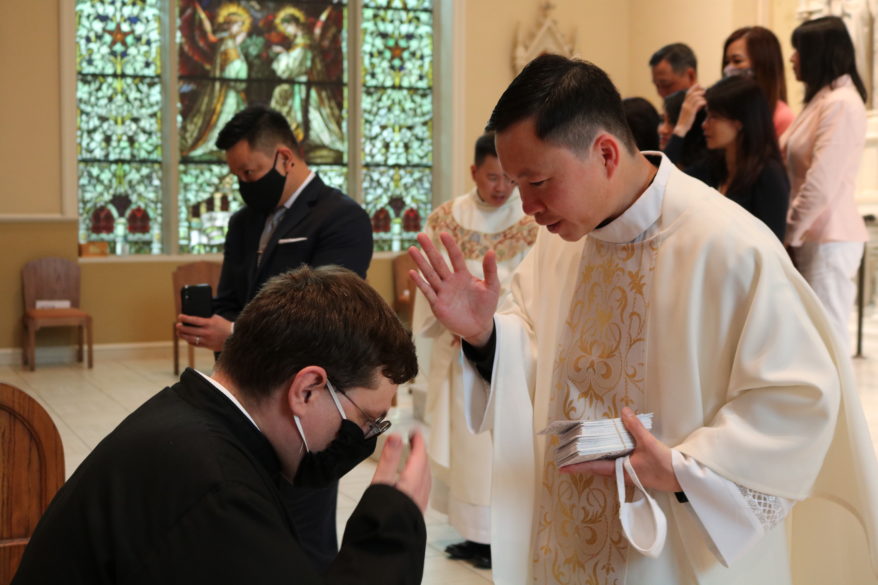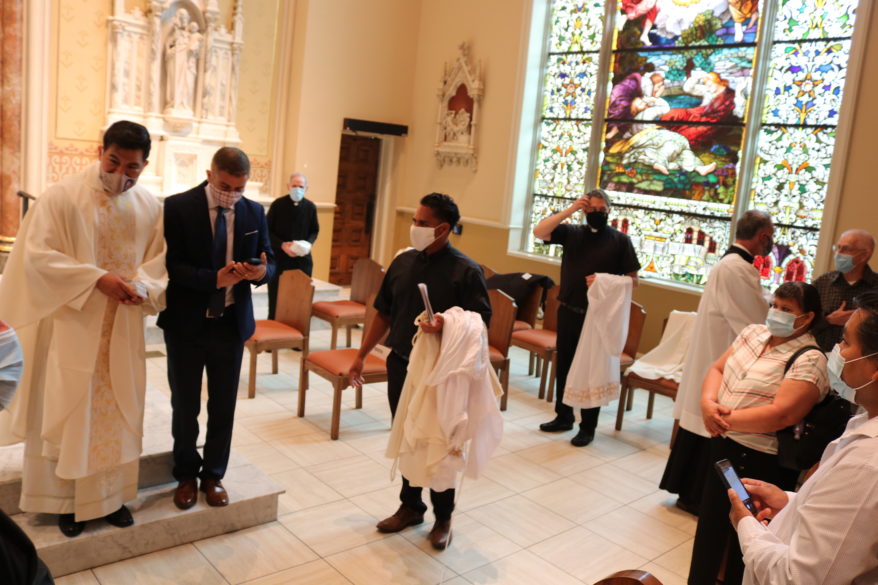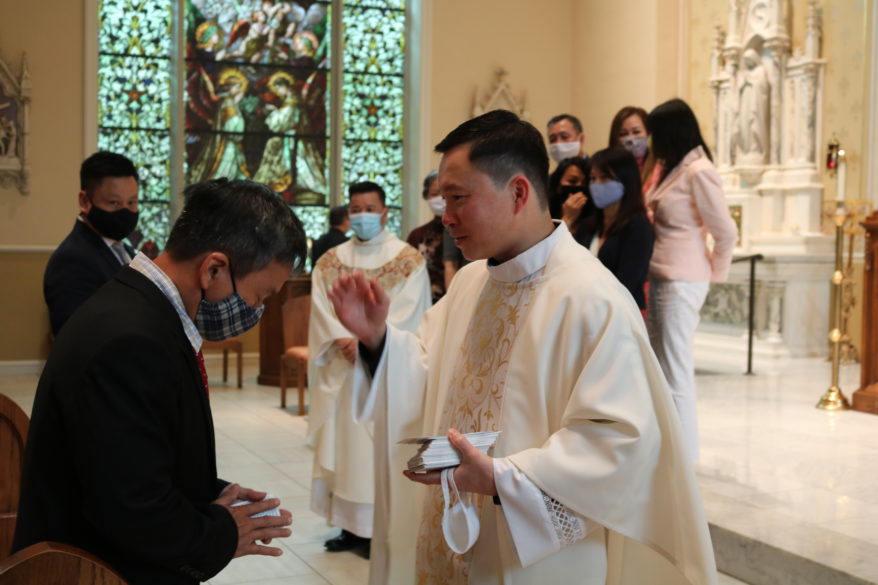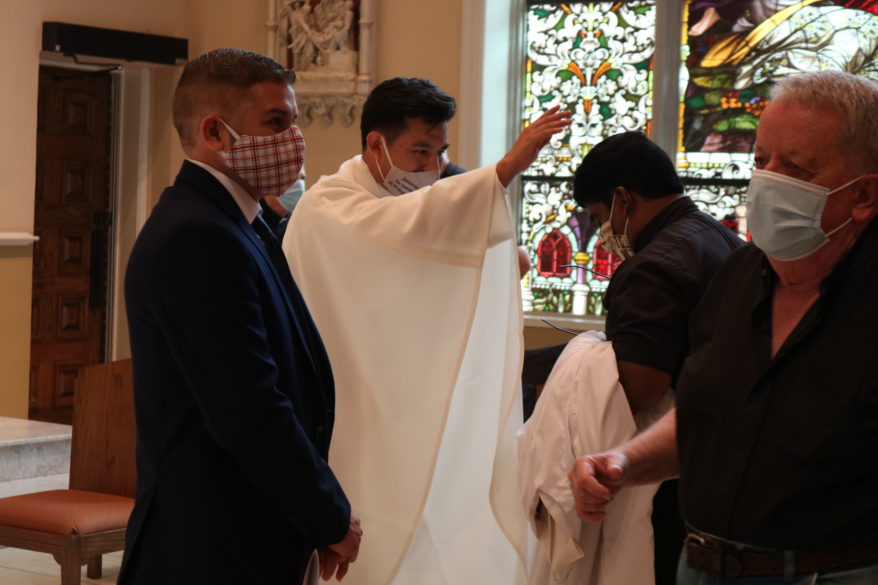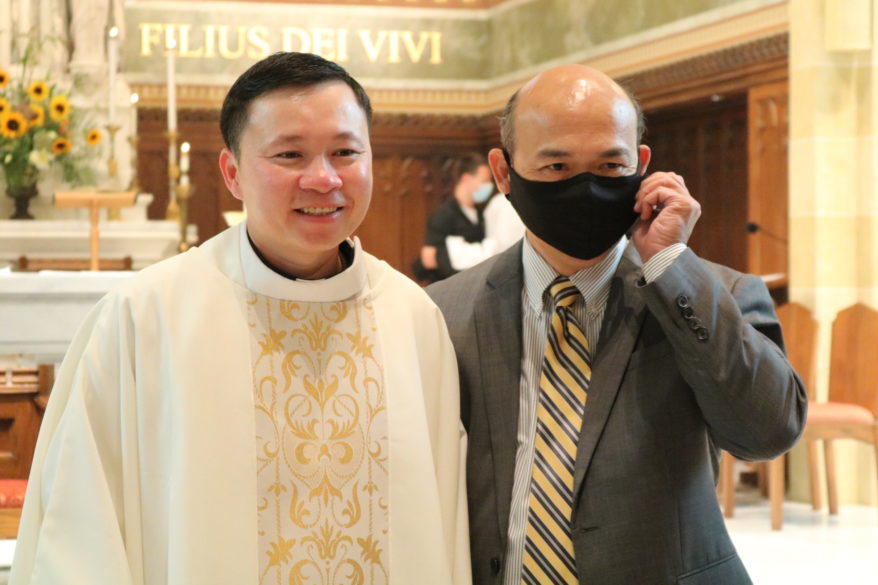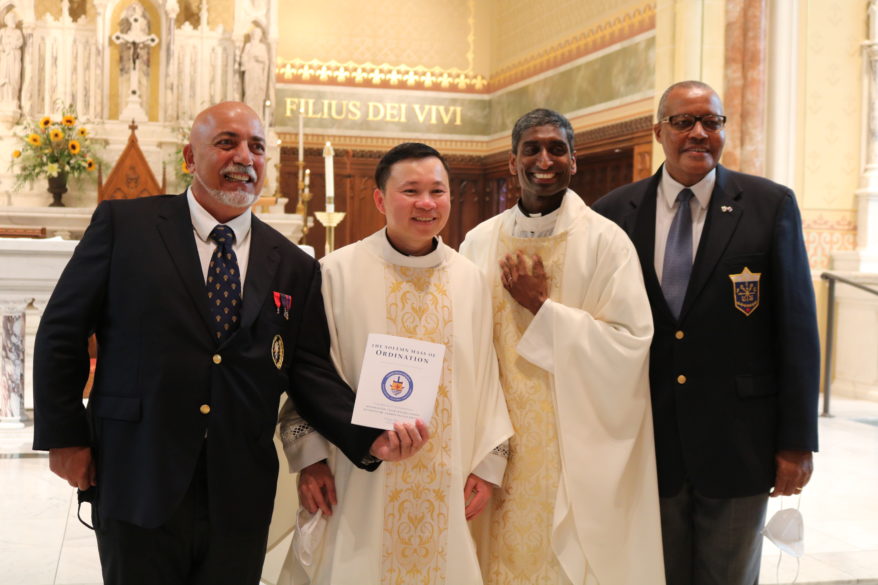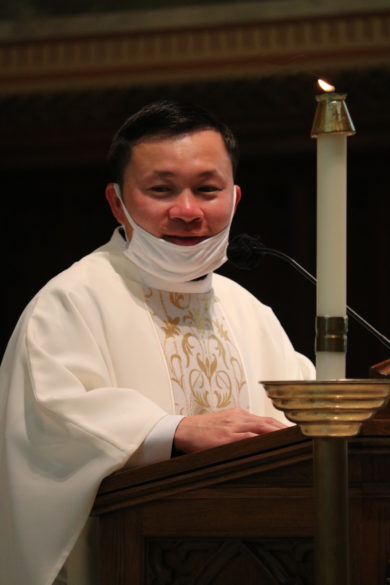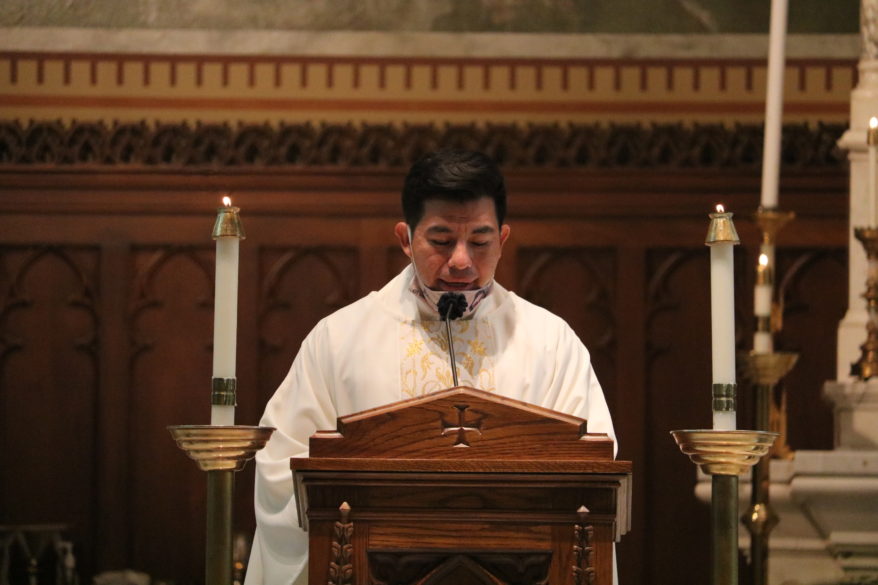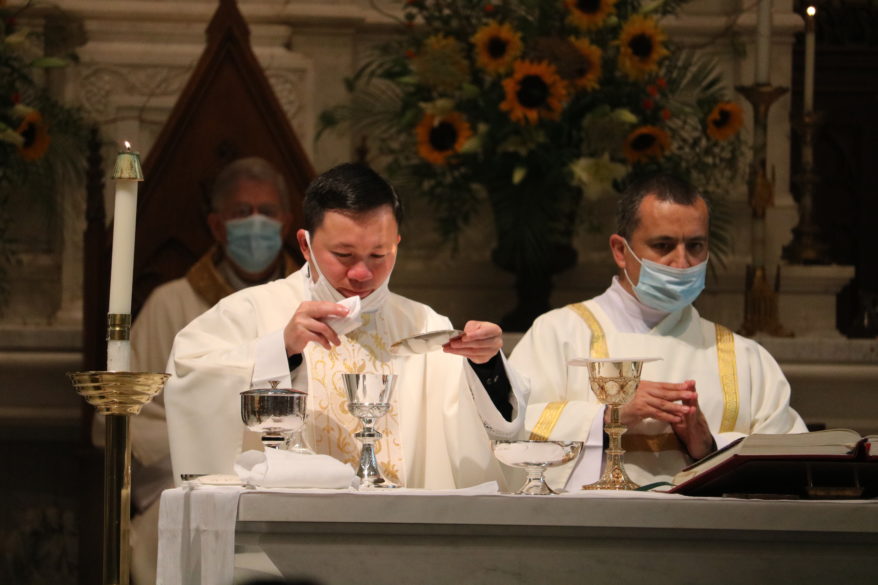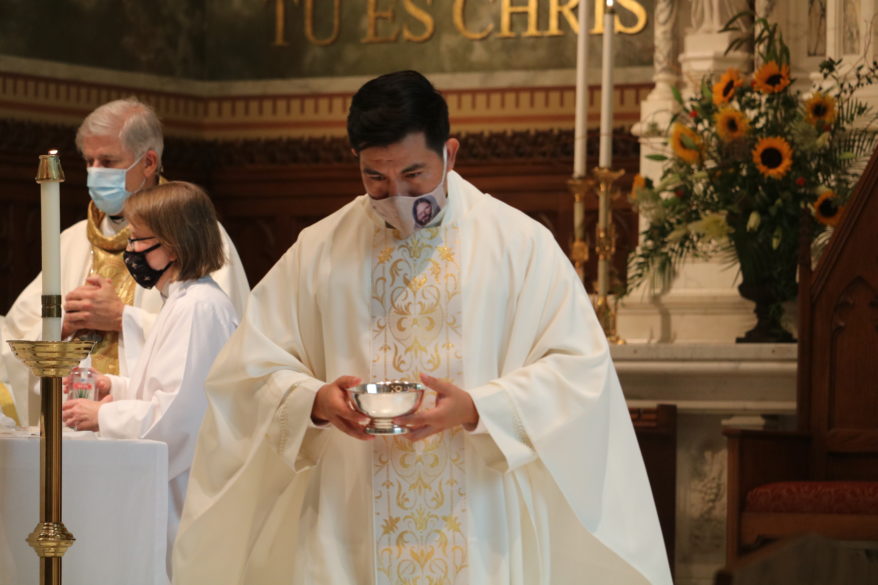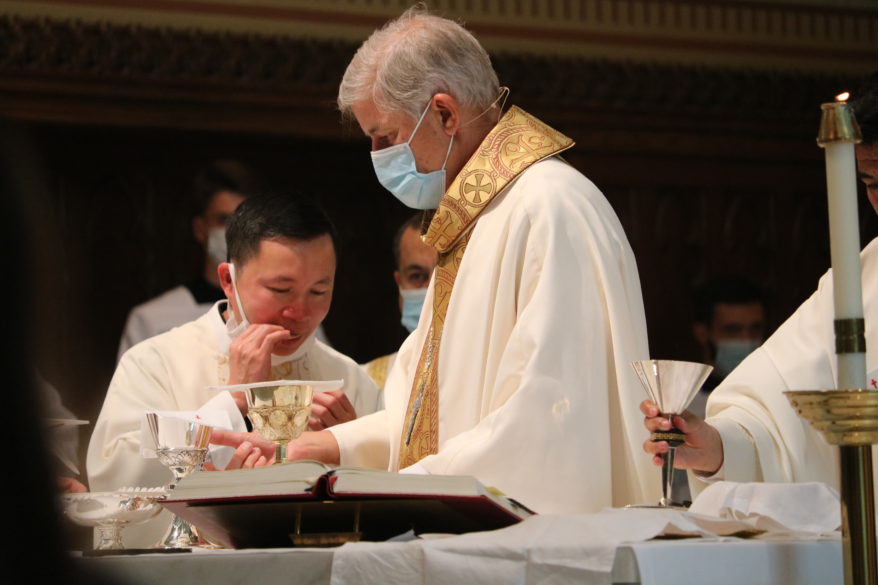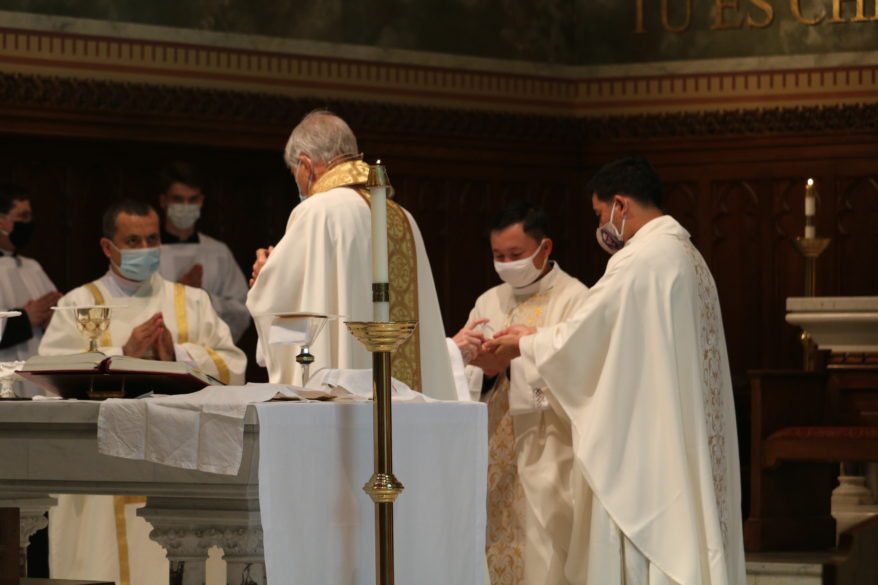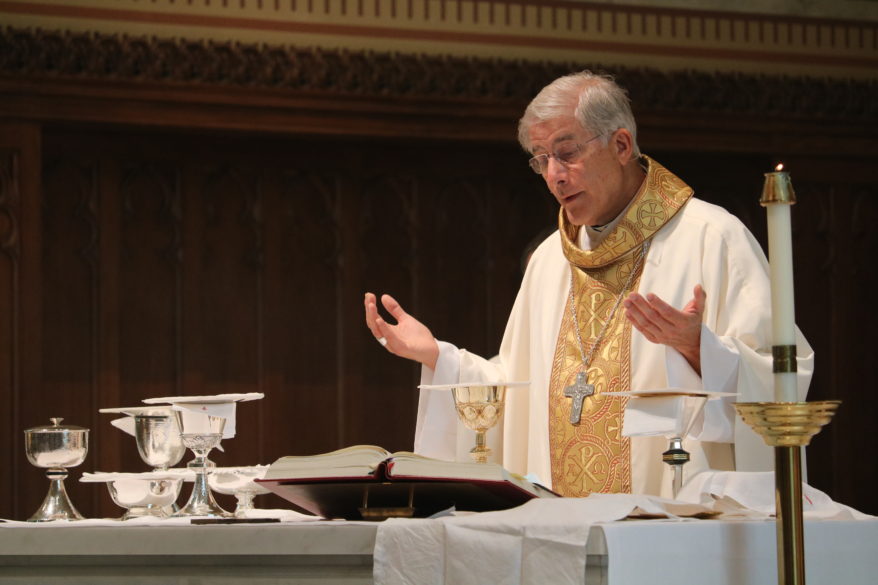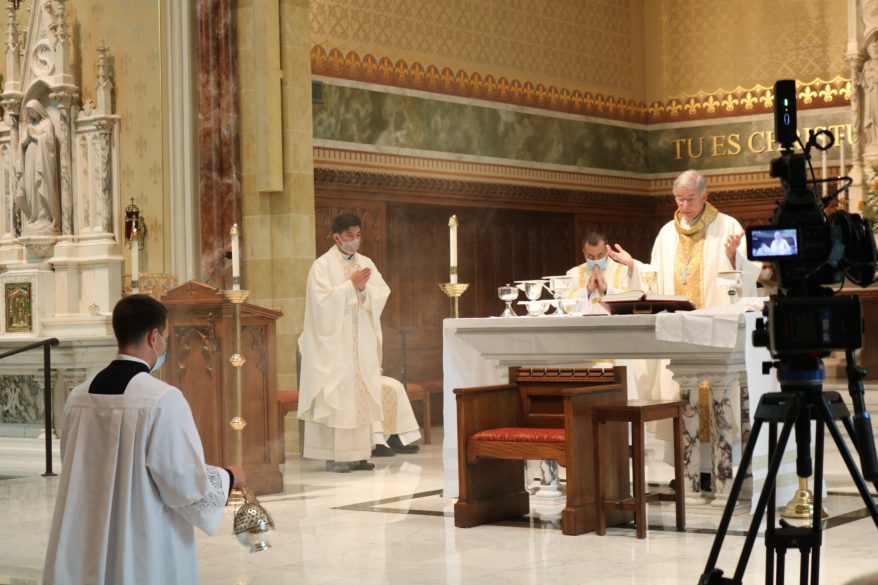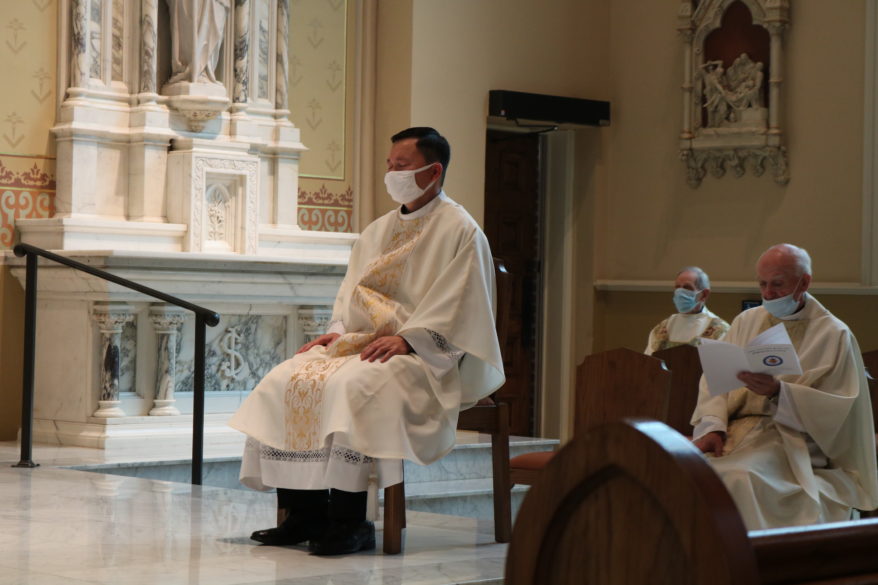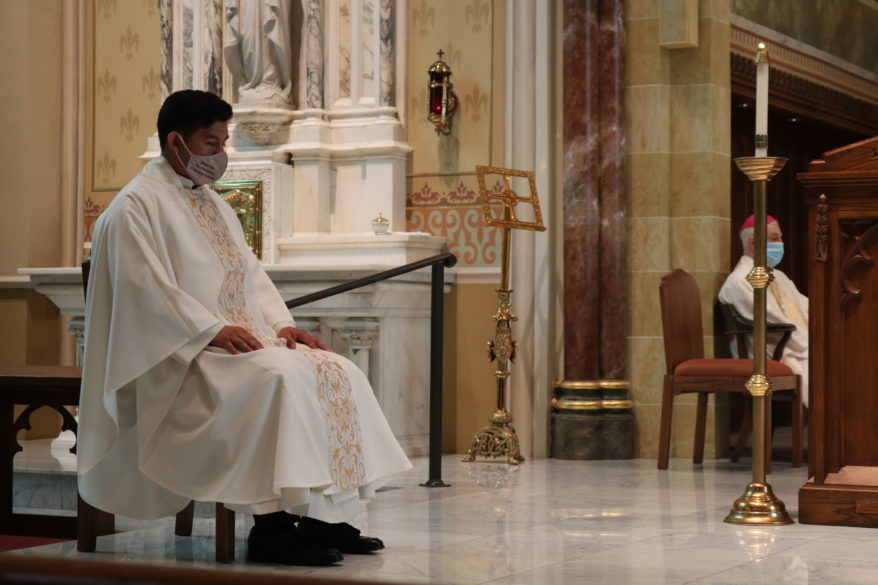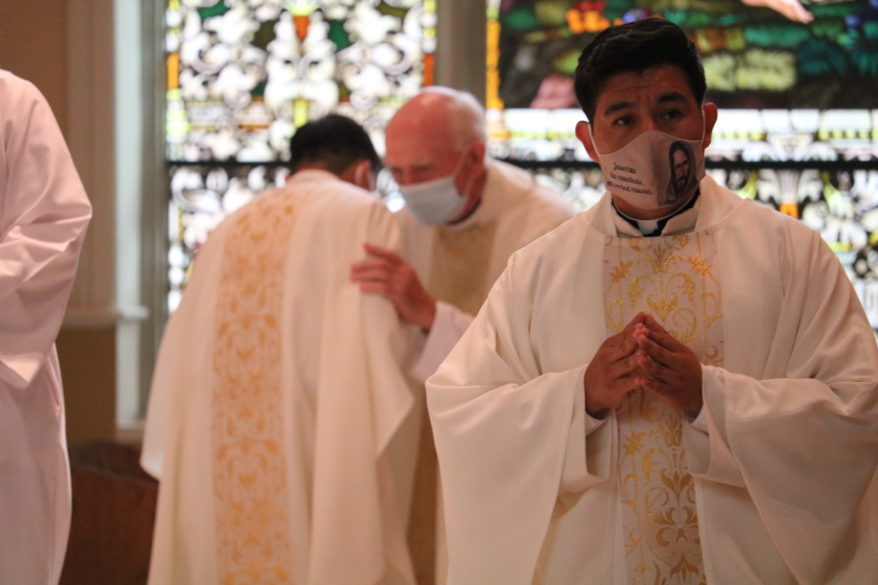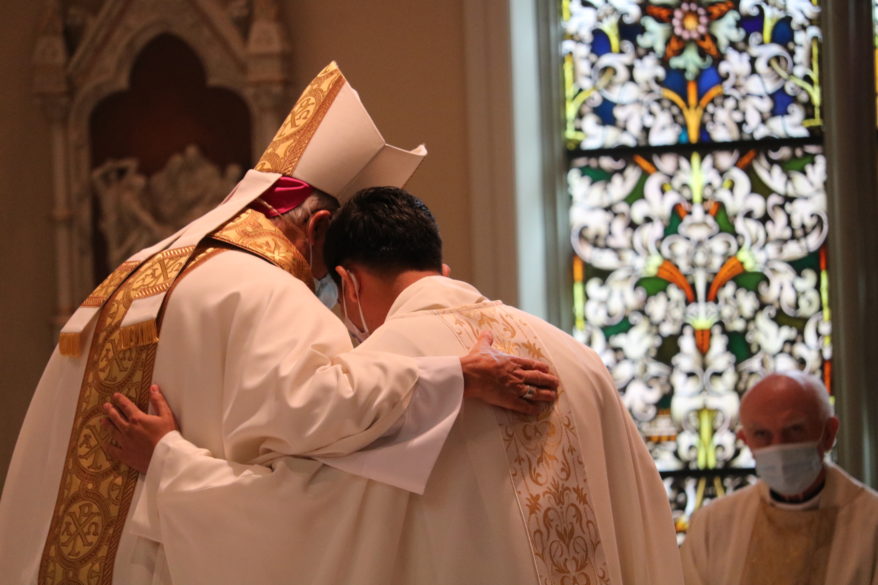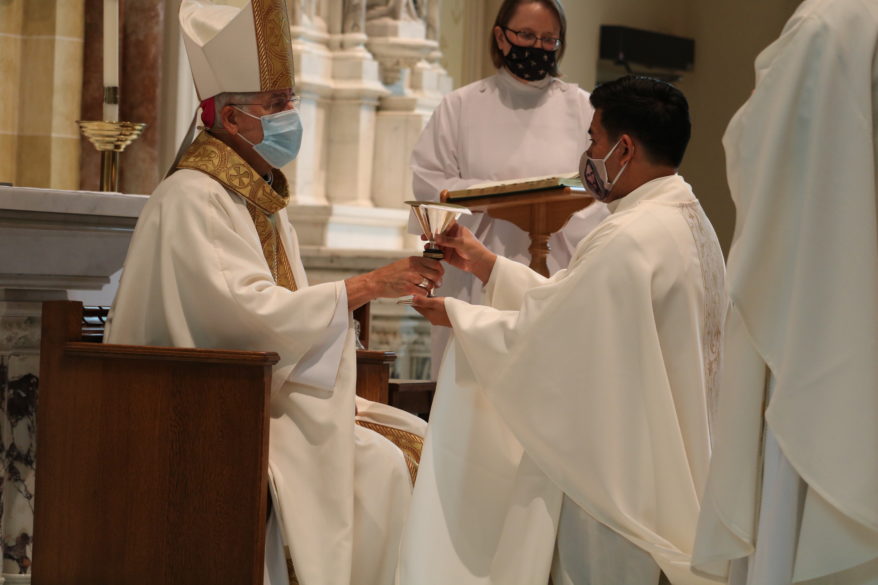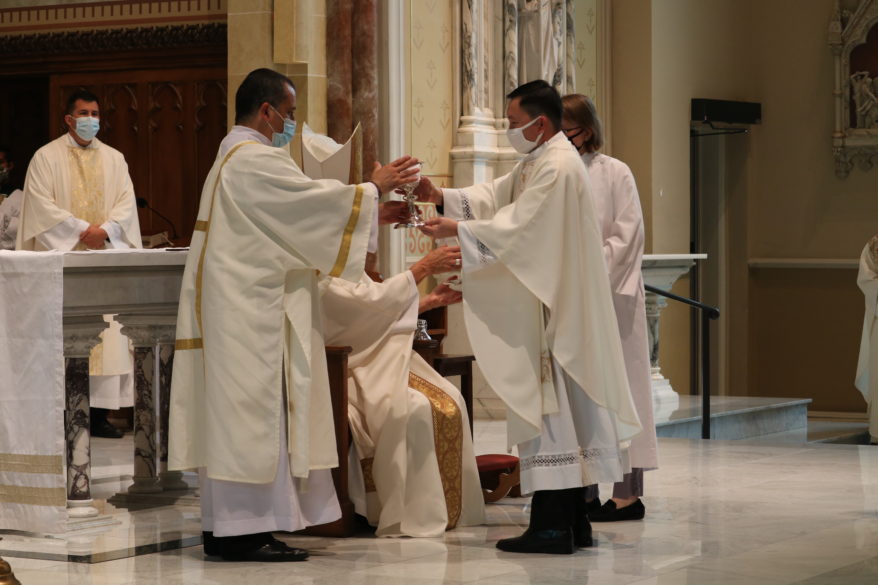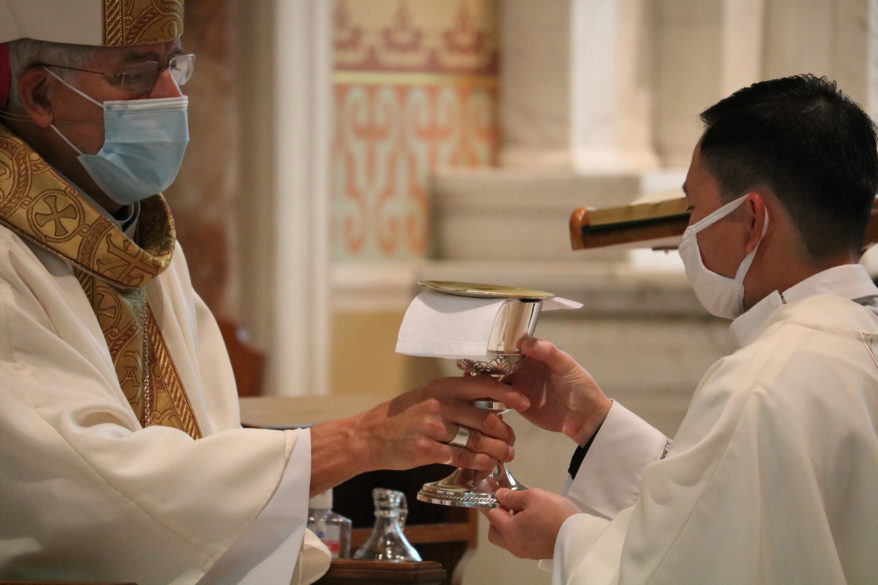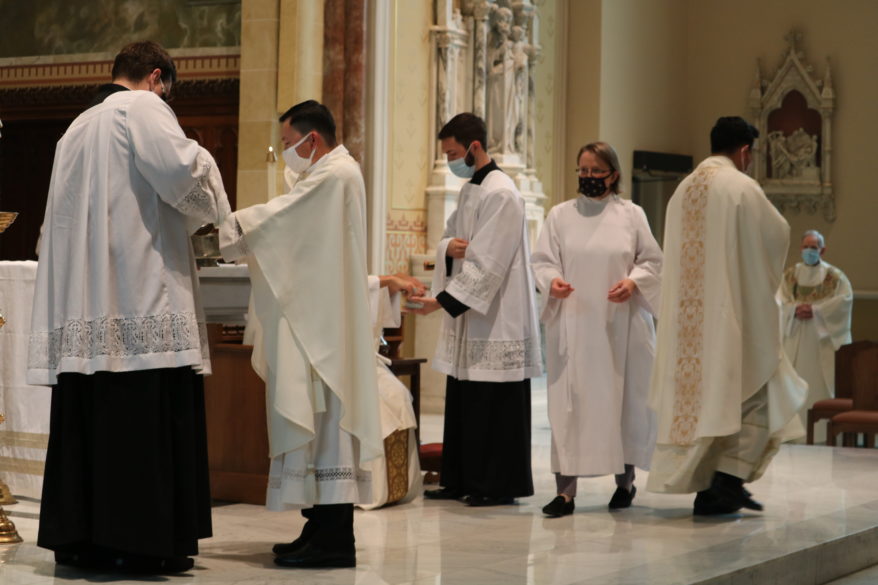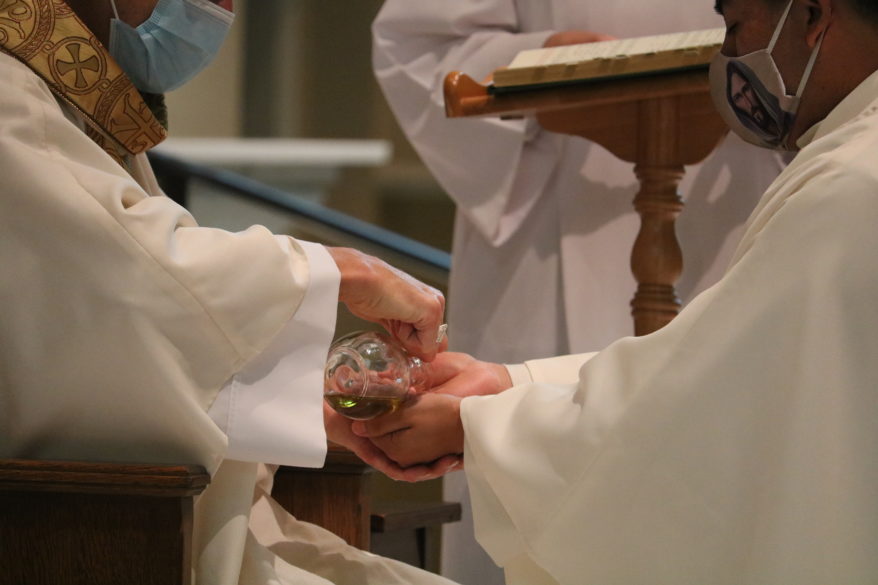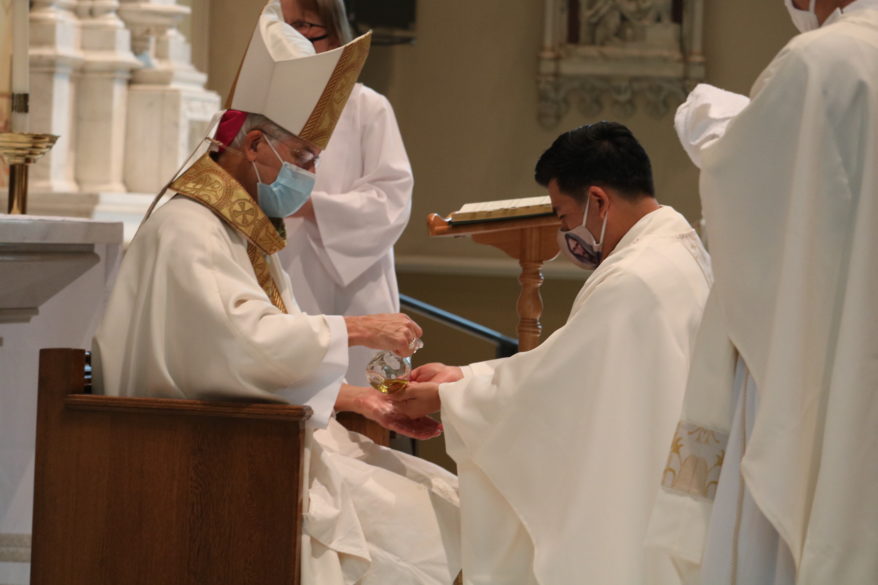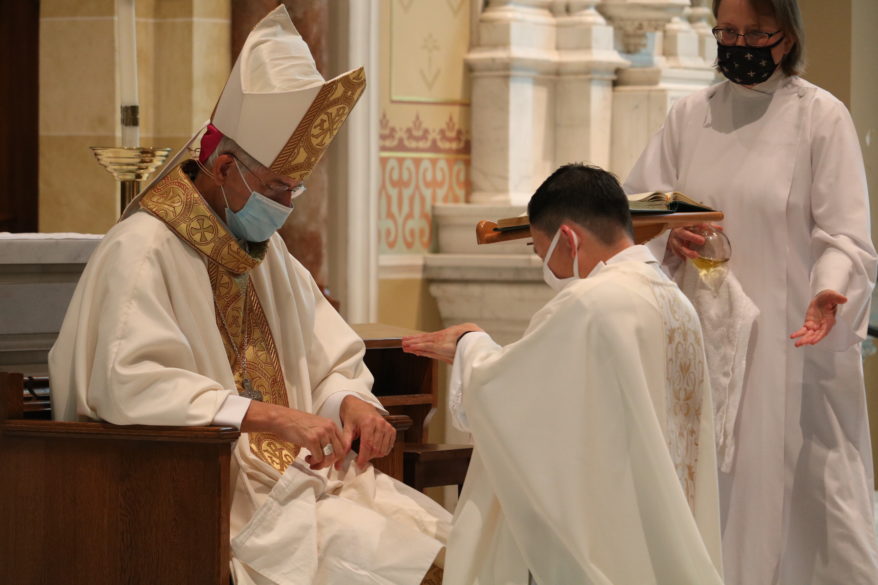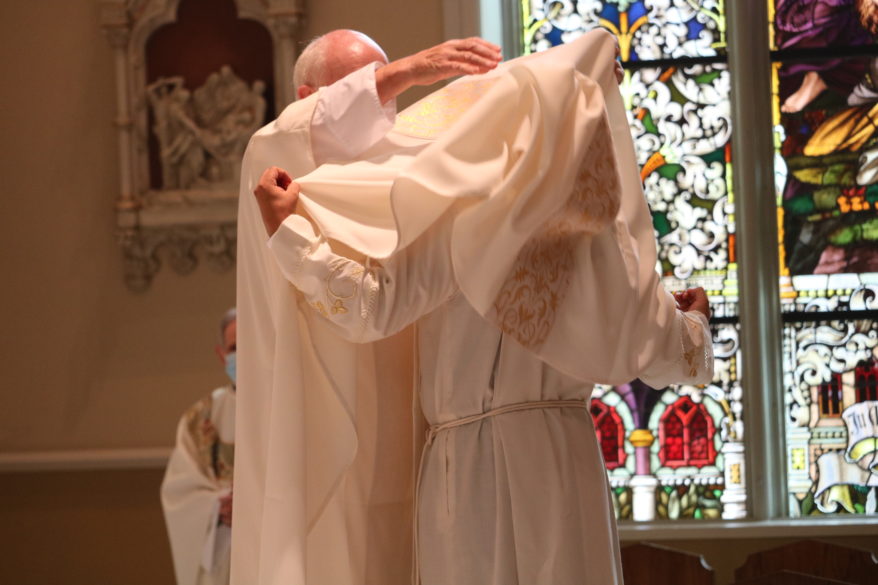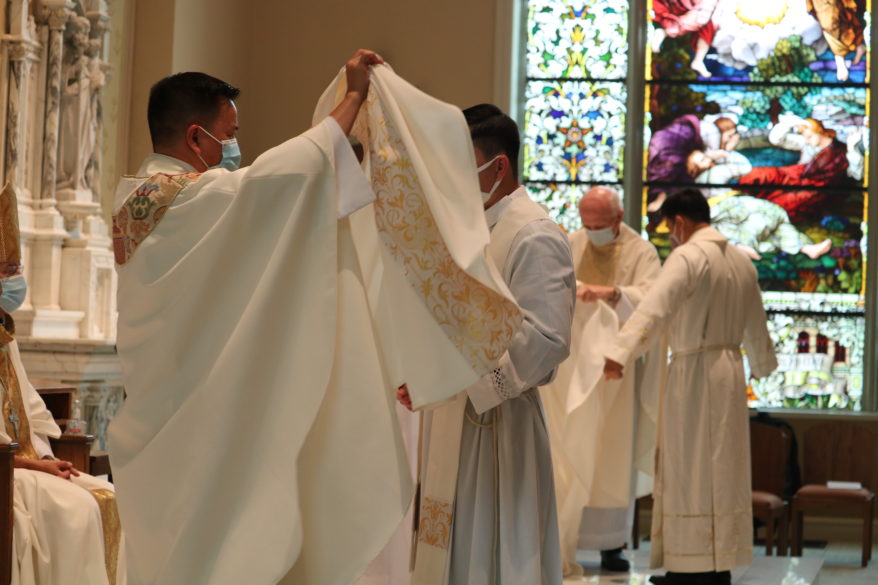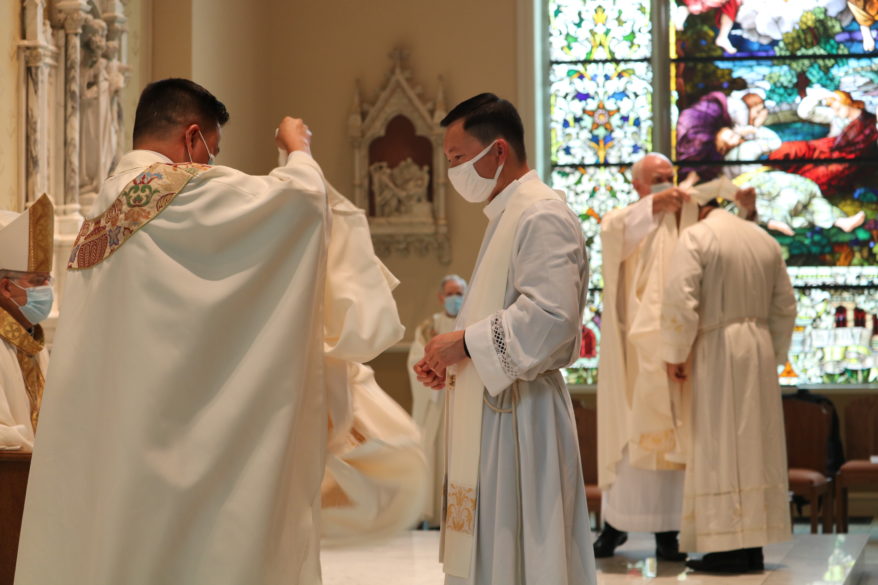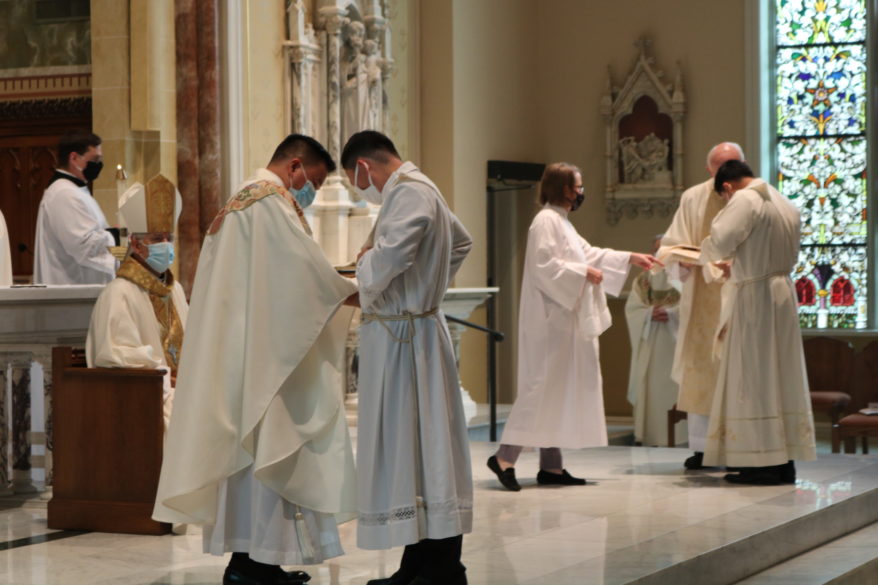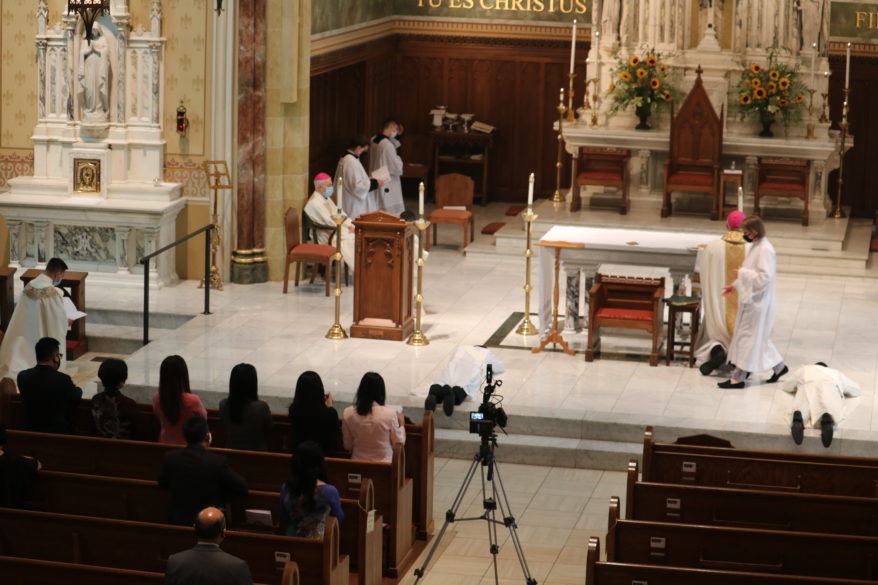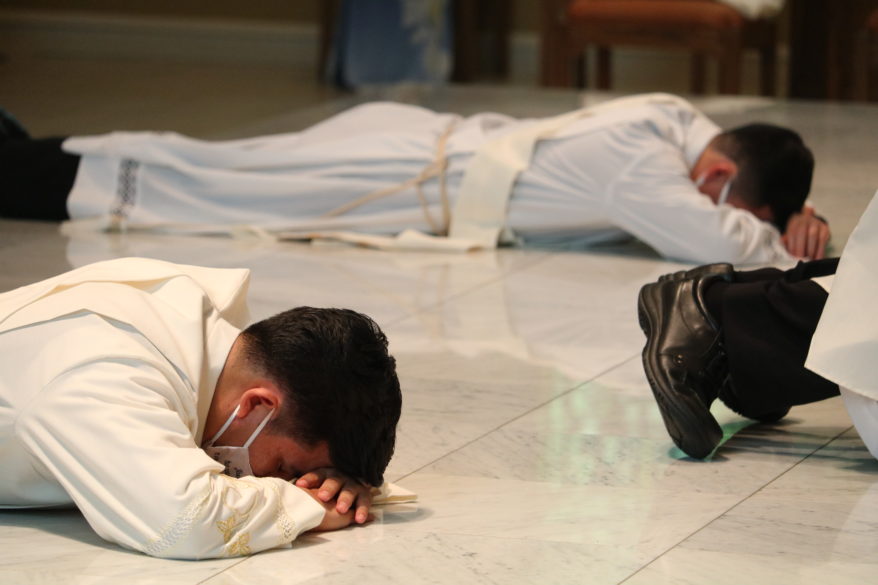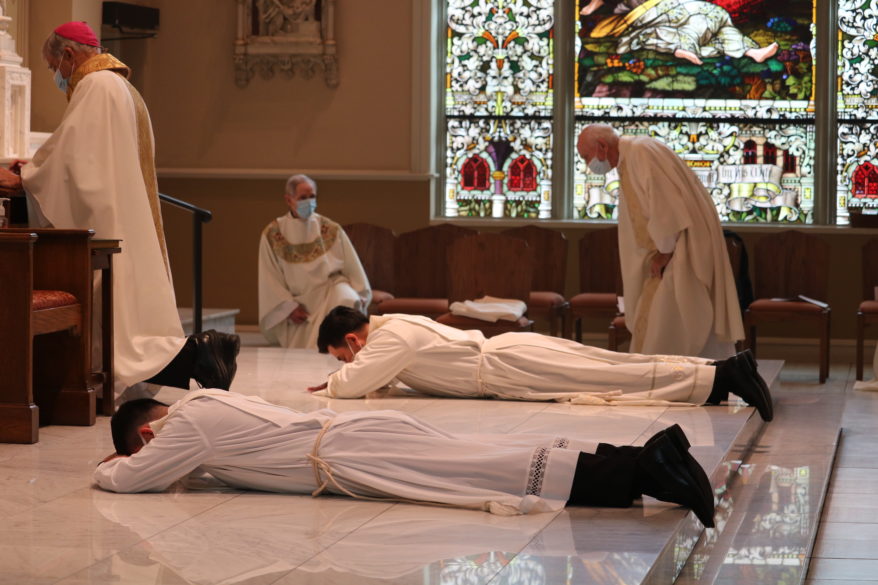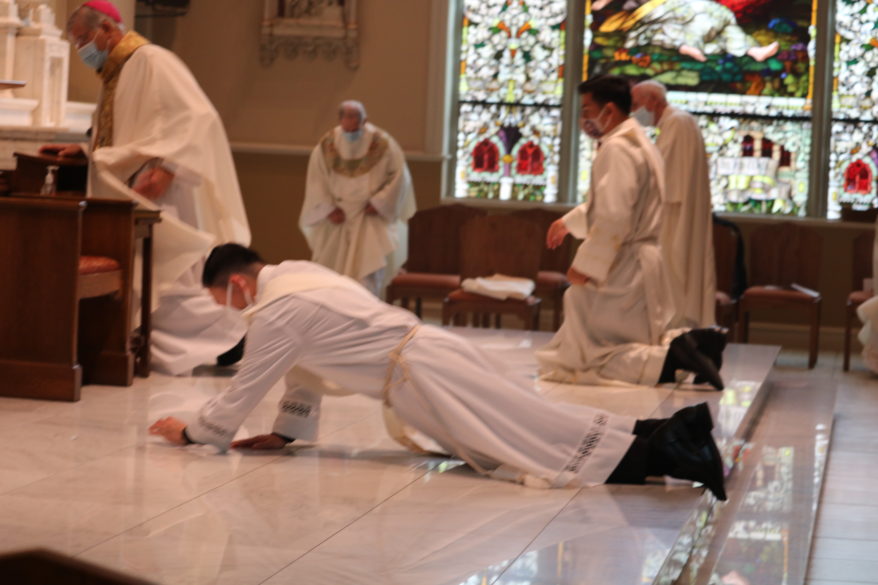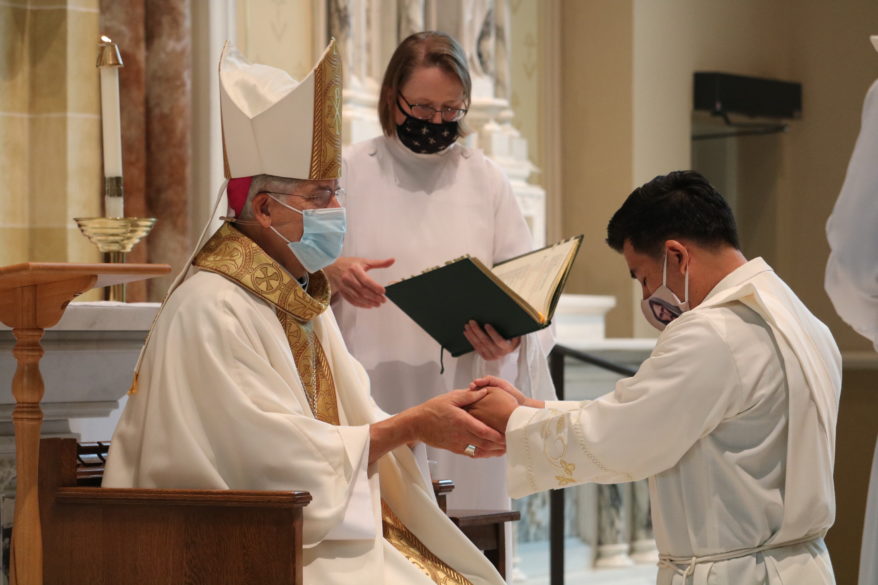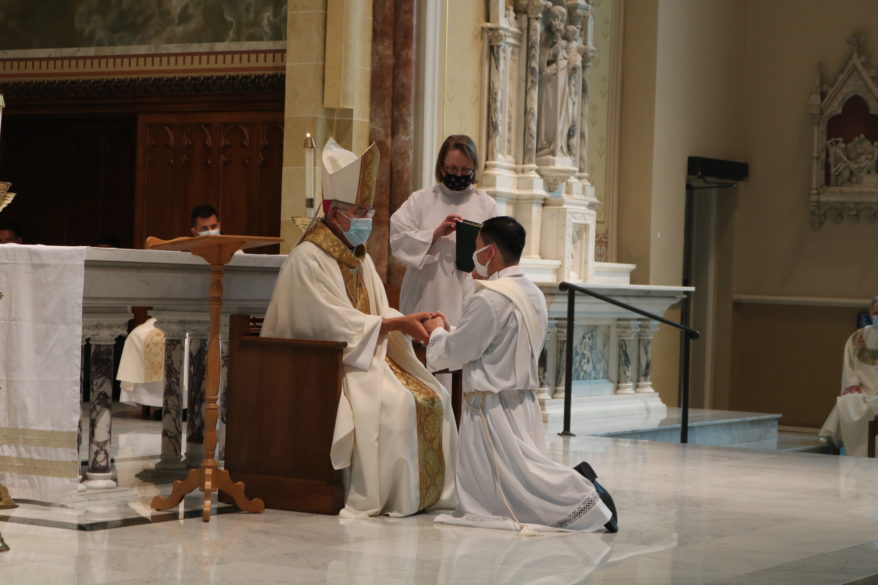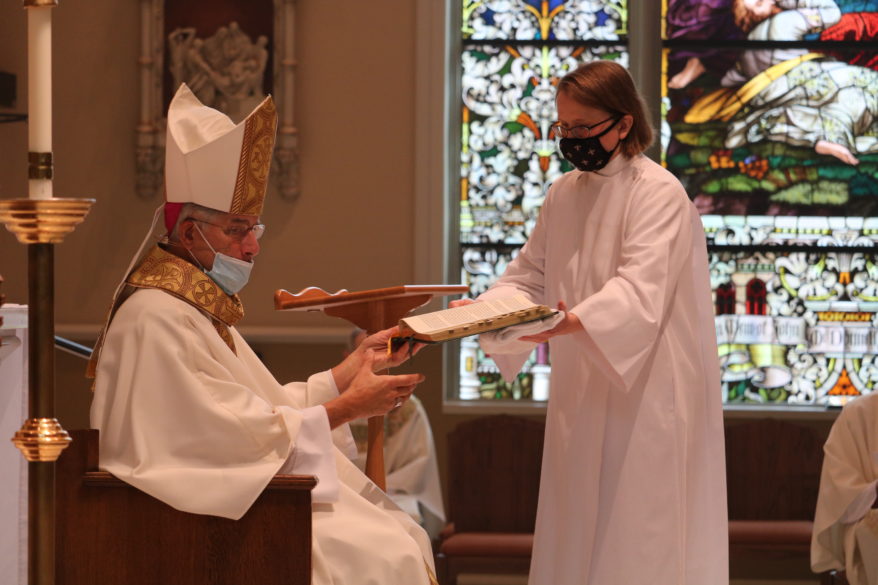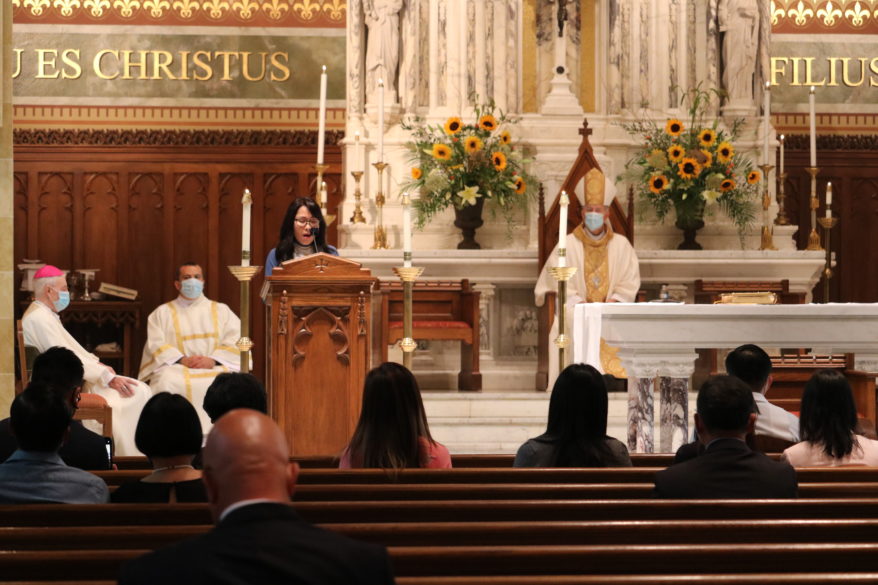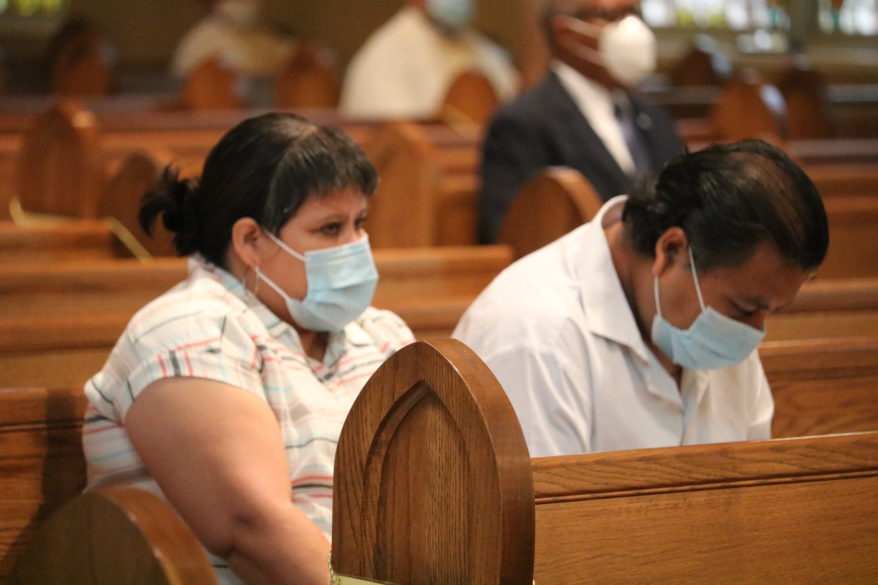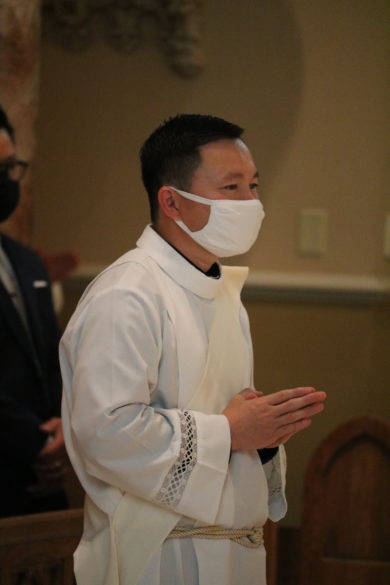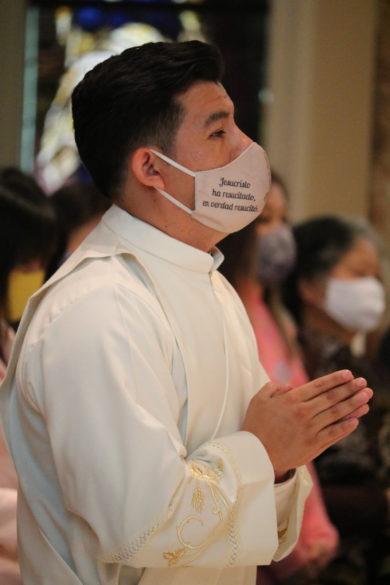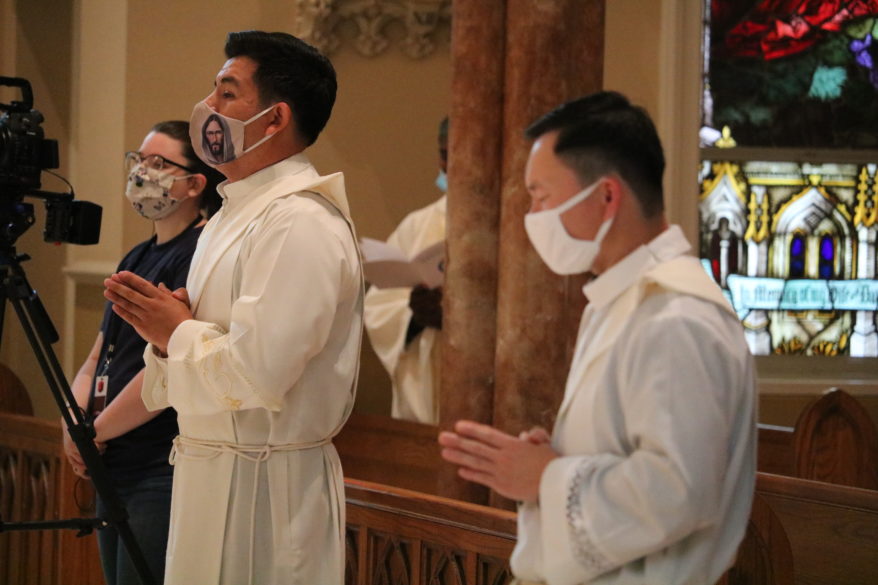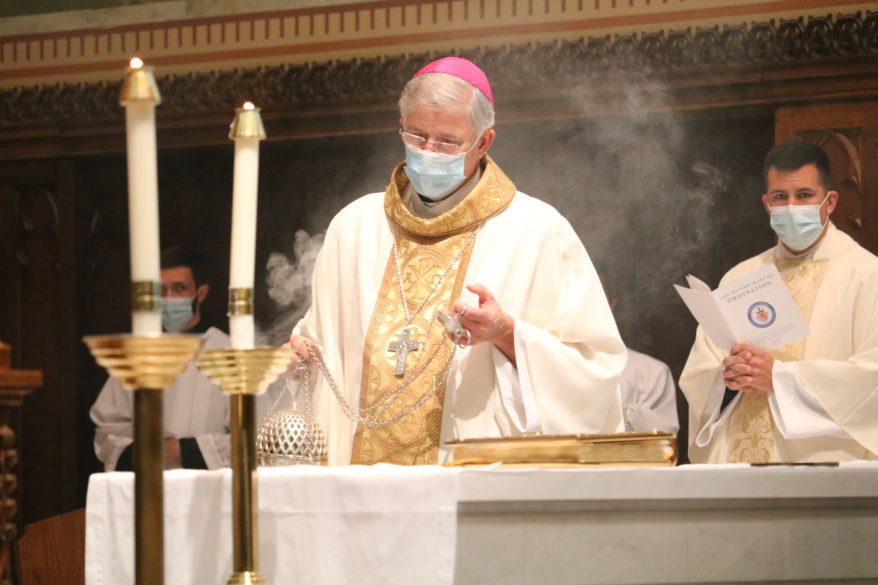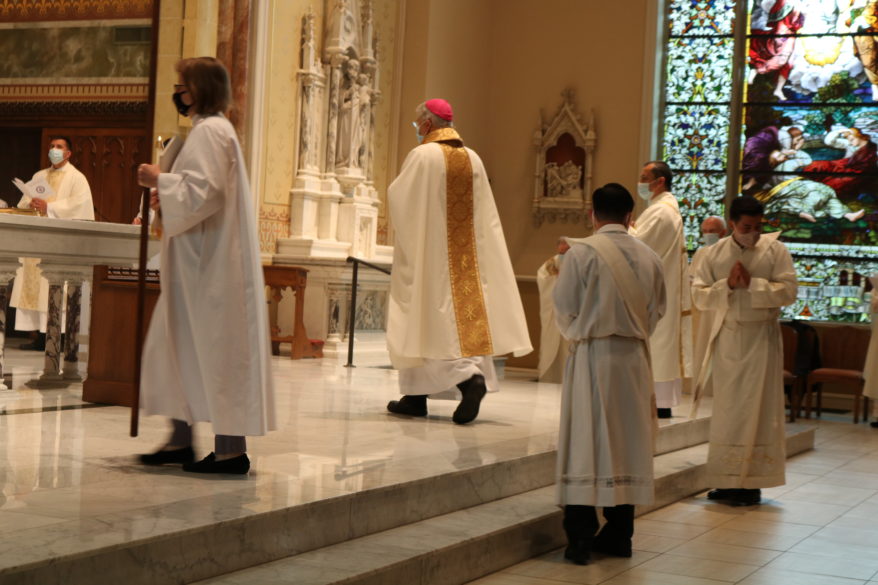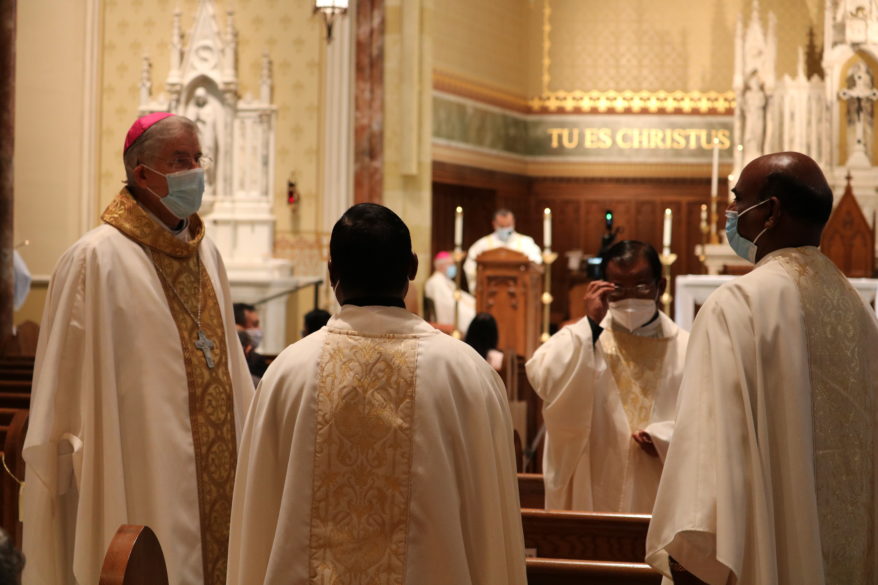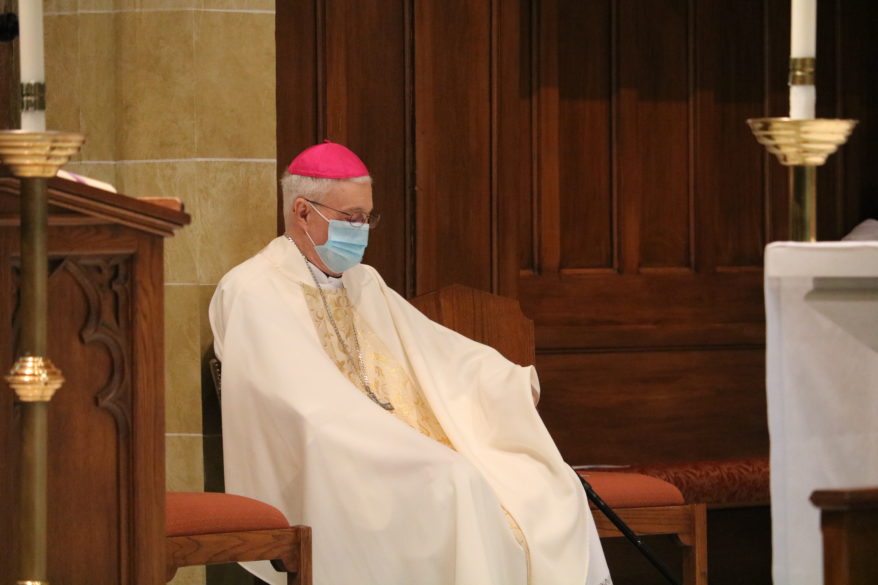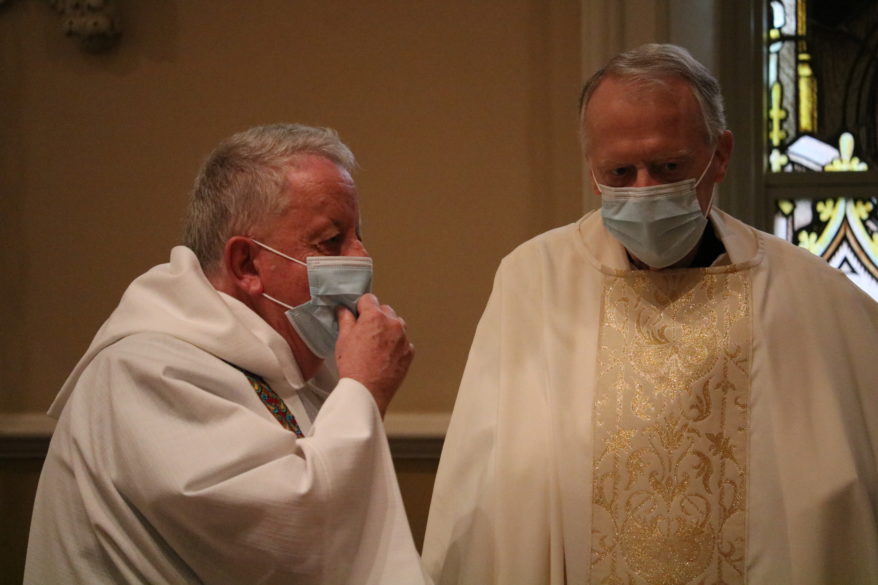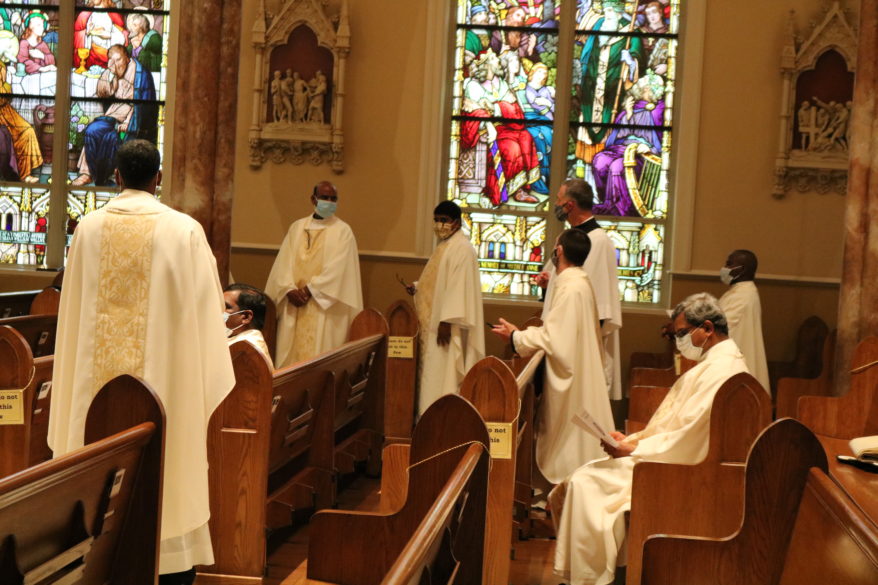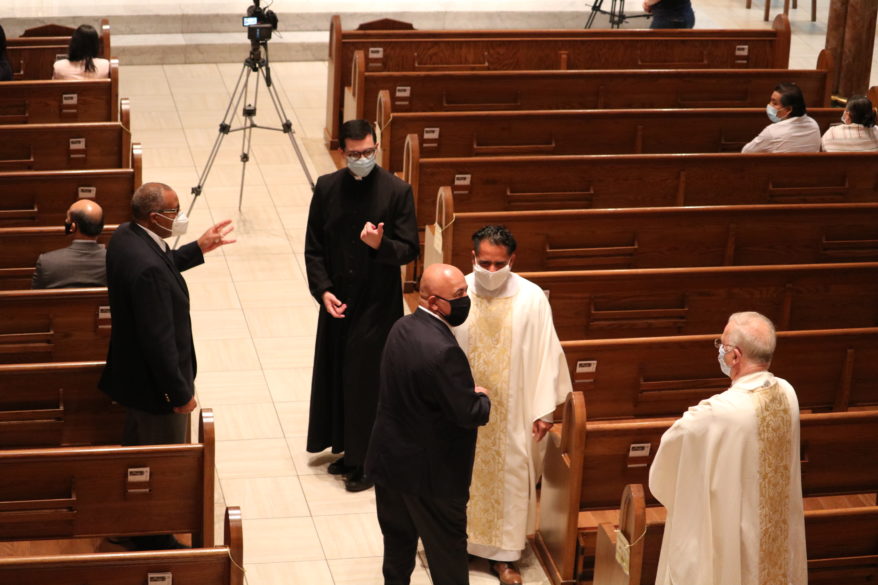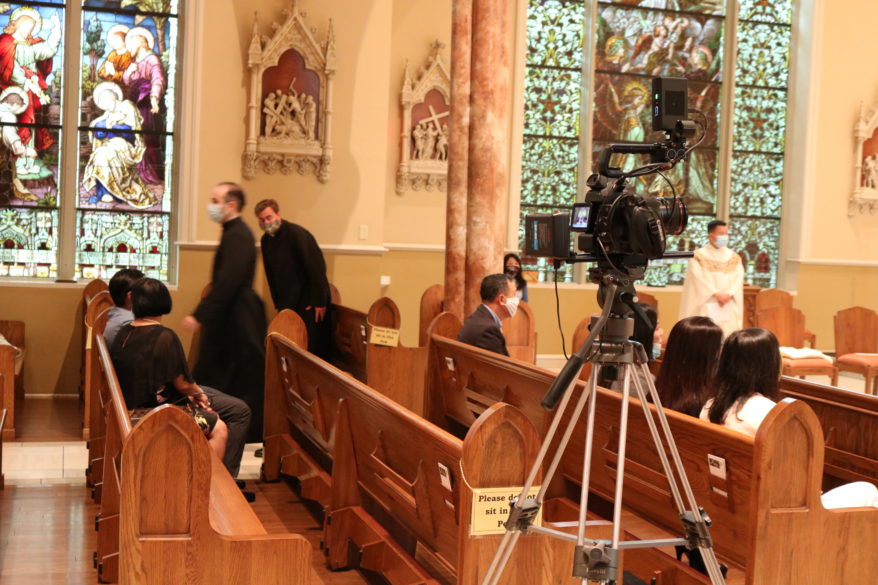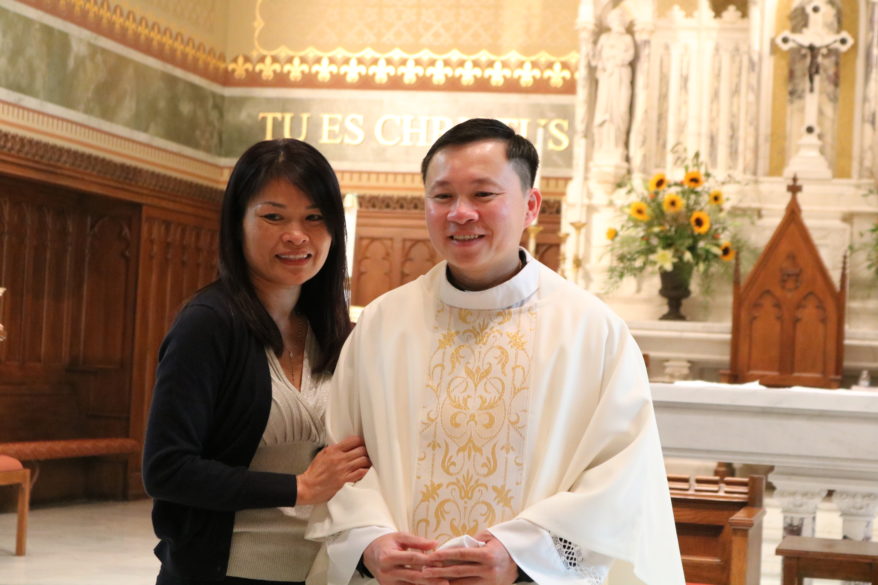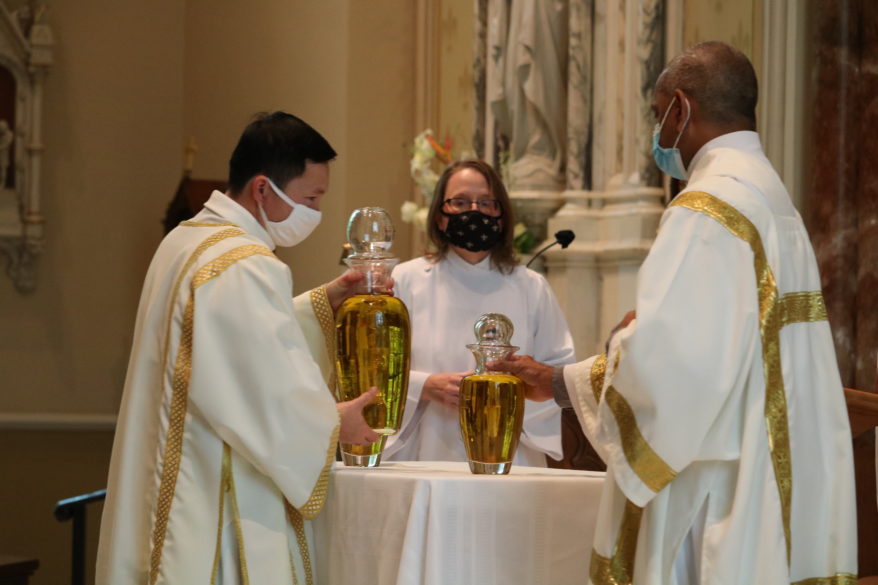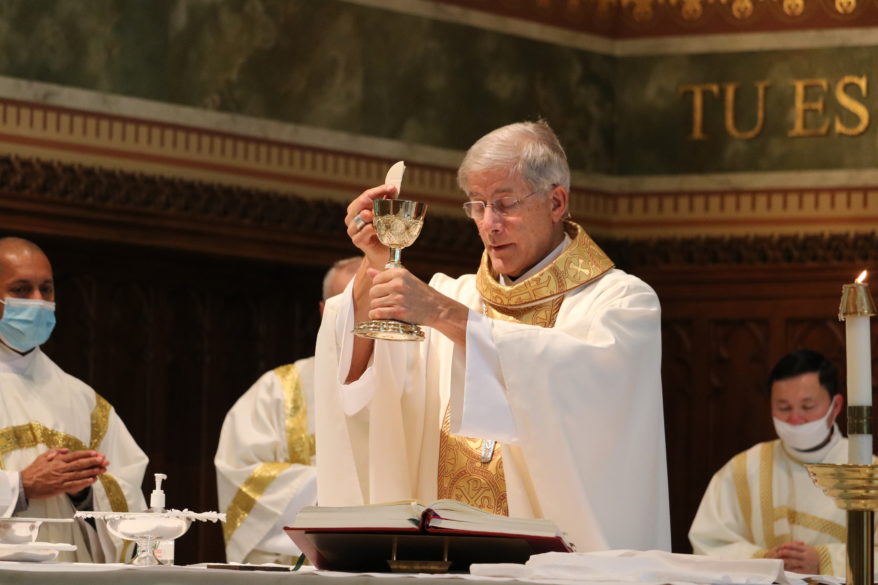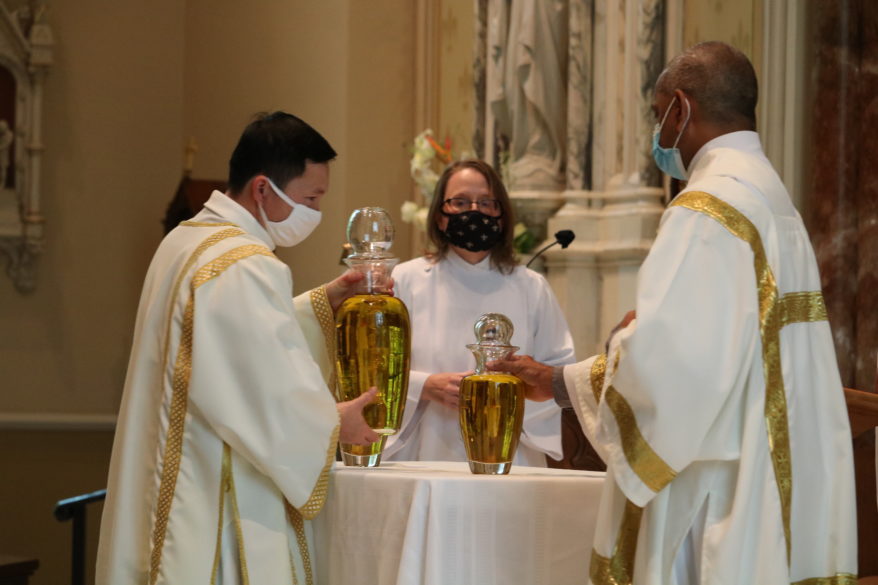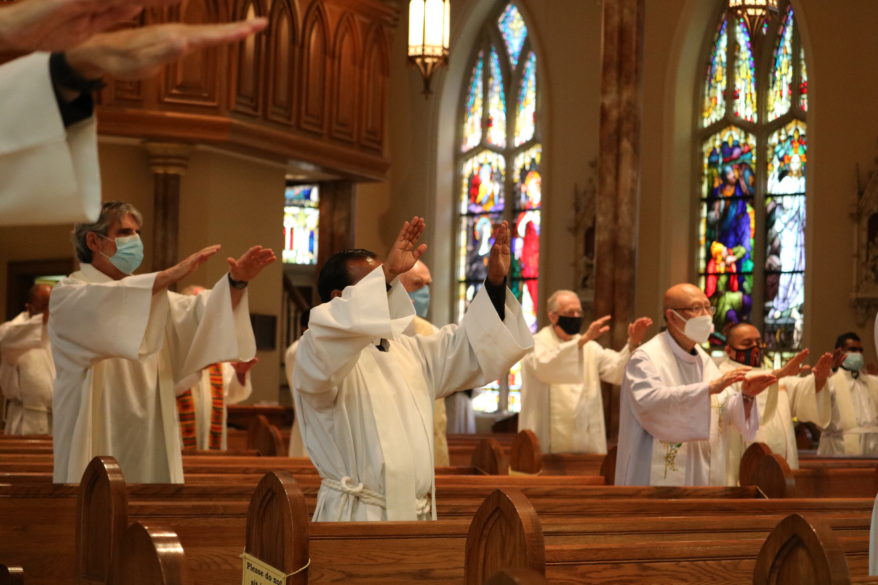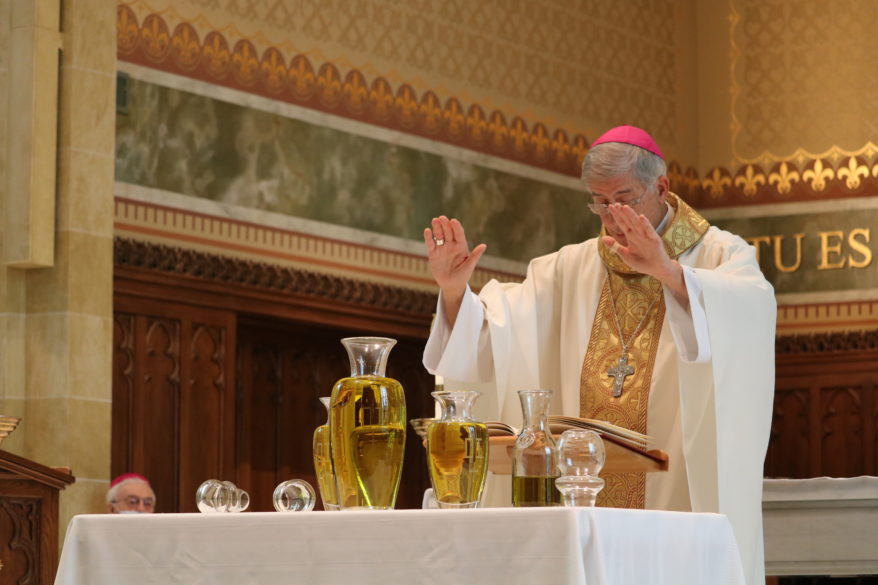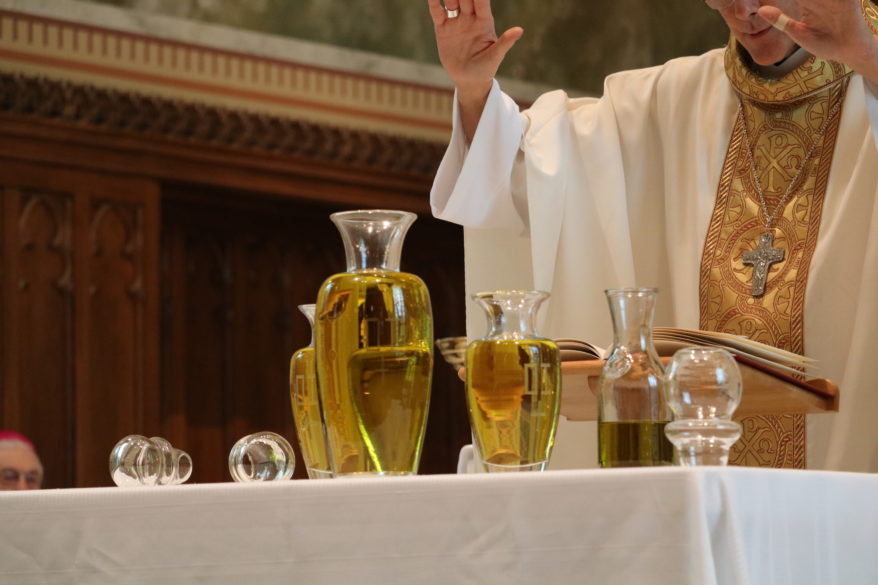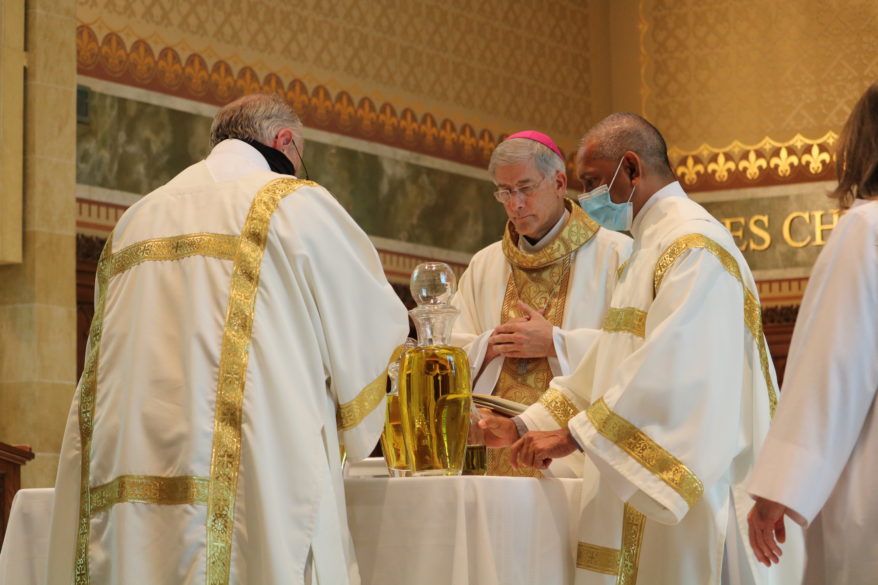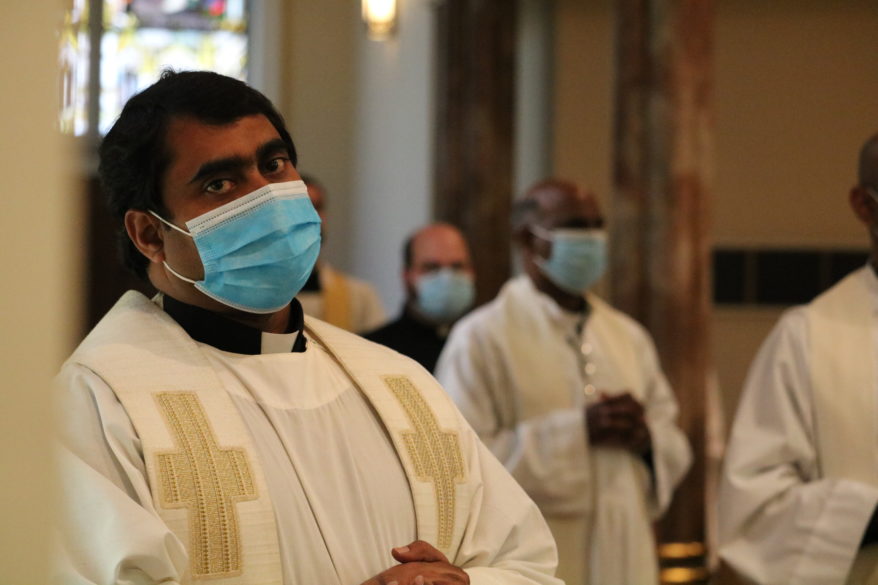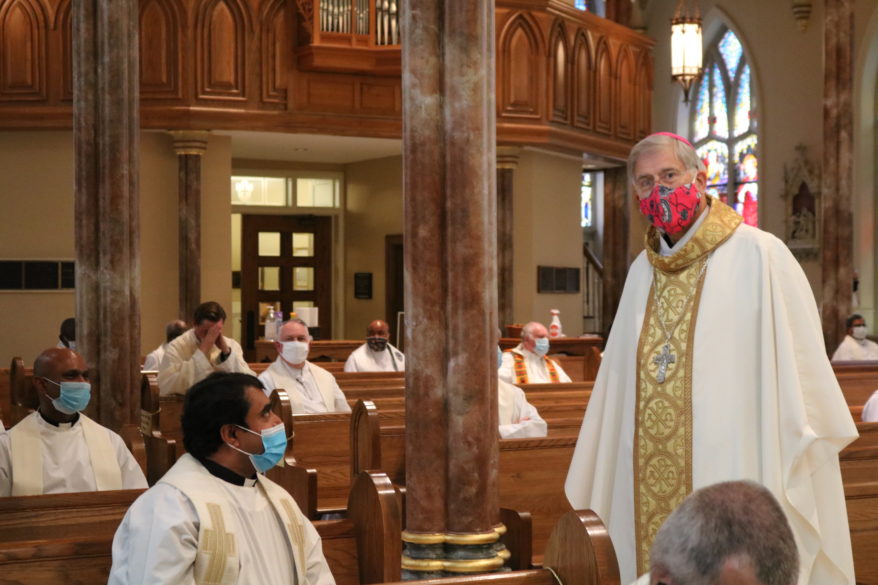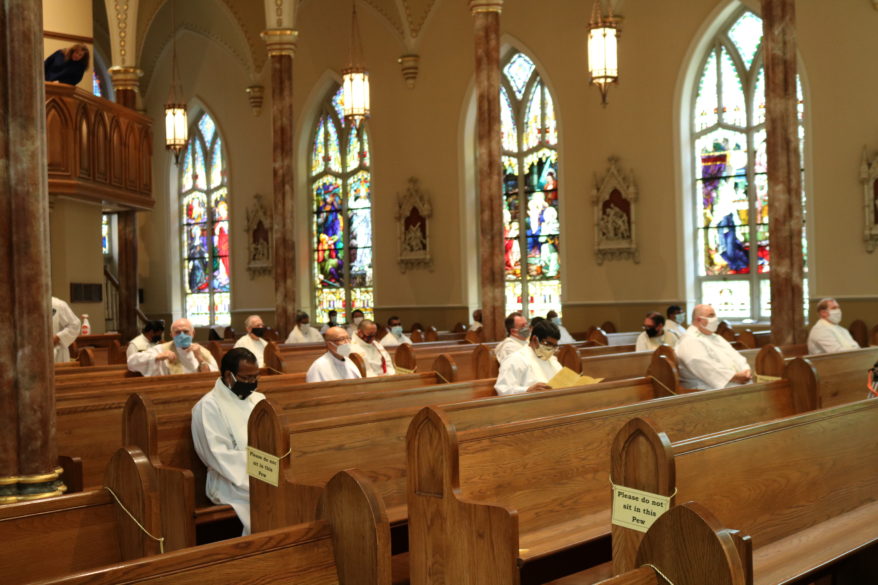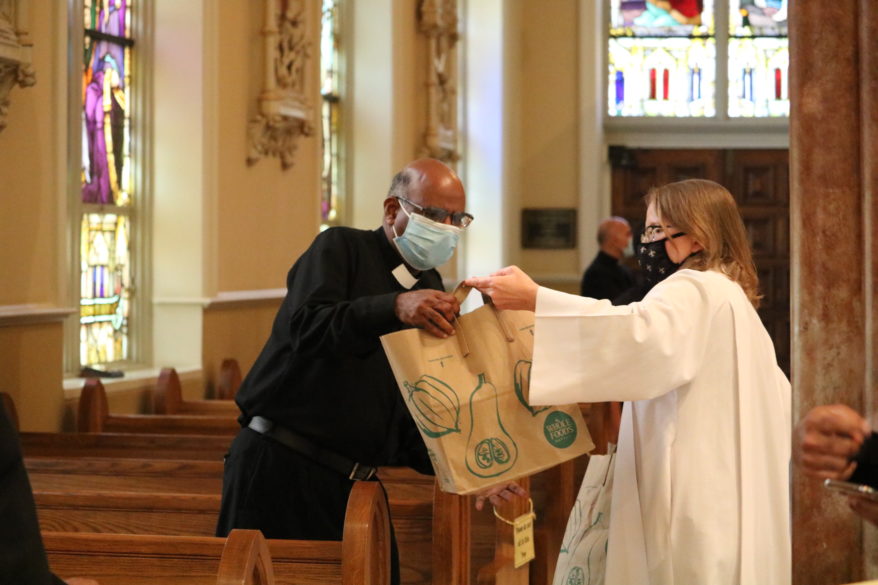Por Berta Mexidor and Joanna Puddister King
JACKSON – El obispo Joseph Kopacz ordenó al sacerdocio a César Sánchez Fermín y Andrew Nguyen en la Catedral de San Pedro en Jackson, el sábado 27 de junio.
Aunque la pandemia de COVID-19 retrasó la ceremonia, programada originalmente para mayo, esto no pudo detener la celebración de los dos hombres que se unieron al sacerdocio.
El evento se hizo diferente debido a las normas de seguridad vigentes. Todos los asientos fueron bloqueados para permitir el distanciamiento social y se alentó a los parroquianos de la diócesis a seguir la transmision en vivo de la Misa de Ordenación a través de Facebook en lugar de asistir en persona. Los sacerdotes diocesanos, seminaristas y algunos invitados especiales seleccionados por los ordenados, todos, llevaban máscaras durante todo el servicio.
“El Señor ha bendecido nuestra diócesis con hombres santos de todos los rincones de la tierra. ¡Bienvenidos, padre Andrew y padre Cesar!,” comentó Mark Beyea, de Clinton, en Facebook. Esta vez, el espíritu de gratitud y felicidad de la ocasión no pudo ser robado por la pandemia.
La Misa de Ordenación también celebró la diversidad cultural de la diócesis, la herencia vietnamita del ahora padre Andrew y la herencia hispana del ahora padre Cesar, que proviene de Michoacán, México.
Al comenzar su homilía, el Obispo Kopacz mencionó la iglesia universal y cómo todos “se reunieron alrededor de la Palabra de Dios cuando esta se proclamó tan hermosa y profundamente en español, vietnamita e inglés” durante esta Misa de Ordenación. El Obispo reconoció también el alcance que tuvo la transmisión en vivo del evento, haciendo que llegara hasta los familiares y amigos del Padre Sánchez, en Michoacán, México, del Padre Nguyen en la ciudad de Ho Chi Minh, provincia de Ninh Thuân en Vietnam.
La Misa de ordenación incluyó muchos momentos emocionantes, especialmente cuando los hombres se postraron, en un acto de humilde oración y rendición, ante el altar cuando se invocaba la letanía de todos los Santos, cantada por el Padre Aaron Williams y los seminaristas Andrew Bowden y Tristan Stovall.
Después de la imposición de manos y la oración de ordenación, se procedió a la investidura de la estola y la casulla de los dos nuevos sacerdotes. El padre Nguyen fue investido por el padre Peter Hoai en Thanh y el padre Sánchez fue investido por el padre Mike O’Brien del Sagrado Corazón en Cantón.
Los padres Andrew y César están siguiendo las Buena Nueva de las Escrituras, y con su ordenación, ambos prometieron al Obispo Kopacz, propagarla para continuar salvando almas.
La felicidad de la ocasión fue compartida en Facebook, con emojis y comentarios de los espectadores:
Jim McCraw, de Jackson, escribió: “¡Felicitaciones, padre Andrew! Amo tu espíritu tranquilo y confiado. ¡Marcarás la diferencia! Tu afecto por Meridian es difícil de ocultar.”
Cony Solano, reaccionó, “Dios es bueno y nos regala nuevos Sacerdotes.”
“Oraciones de acción de gracias por estos dos jóvenes por responder al llamado al sacerdocio. Que el Señor los bendiga en su servicio,” escribió Mary P. Robinson de Madison.
Izamar Mazy, de la Catedral de San Pedro escribió, “Que bendicion, lo tendremos en nuestras oraciones, Gracias por darle el SI al Señor!!”
Después de la celebración de la Eucaristía, el obispo Kopacz invitó al padre Cesar y al padre Andrew a hablar, desde la distancia, con sus familiares que no pudieron estar presentes en el evento debido a la pandemia.
En sus lenguas maternas e inglés, el padre César cerró diciendo que ha tenido un maravilloso sistema de apoyo de todos aquellos en la Diócesis de Jackson y que “siempre se ha sentido como en casa, …Y sabes que el hogar es donde está tu corazón, así que realmente siento eso. Ahora, la diócesis de Jackson es mi segundo hogar,” concluyo el padre César y a su vez el padre Andrew habló en vietnamita con los miembros de su familia, presentes y lejanos, agradeciendo a todos por sus oraciones y apoyo. En sus comentarios finales, el Obispo Kopacz les pidió a todos el “continuar orando por los sacerdotes … y continuar juntos como el pueblo del Señor”.
Al final de la Misa ambos sacerdotes bendijeron a algunos de los presentes. Por la tarde de este día, el padre César bendijo además a los parroquianos del Sagrado Corazón en Cantón, quienes viajaron en caravana alrededor de la iglesia, para recibir la misma desde sus autos.
El padre César es nombrado vicario parroquial en St. James Tupelo y St. Christopher Pontotoc, donde celebró su primera Misa el Domingo 28
El padre Andrew es nombrado vicario parroquial en las parroquias de San Patricio y San José en Meridian. Celebró su primera Misa en la parroquia Asunción de Maria, en Luisiana, el 28 de junio.
Category Archives: Diocesan News
Tenemos que pensar en los demás
Por Daisey Martinez
“La gente de Choctaw cree que cuando tienes una habilidad o un regalo, se lo das a otra persona de la familia, y creo que mi abuela me dio estos regalos, el de de costura, Kaylee y Michelle,” dice Tina Routh.
Tina, su hija Kaylee Routh, su prima Michelle Hickman y su amiga Gwendolyn Hickman han realizado hasta el momento más de 4,536 máscaras faciales. Promedian alrededor de 100 máscaras por día.
Este proyecto comenzó a mediados de marzo cuando estas mujeres de buen corazón notaron la necesidad de máscaras en su comunidad. Al principio, solo las estaban distribuyendo a familiares y amigos, pero luego creció su pequeño proyecto. Han estado proporcionando máscaras a diferentes departamentos a lo largo de la Reserva y al Centro de Salud Choctaw que más ha necesitado las mismas. También envían máscaras a otras personas que viven en diferentes Reservas y a miembros tribales que viven fuera del estado.
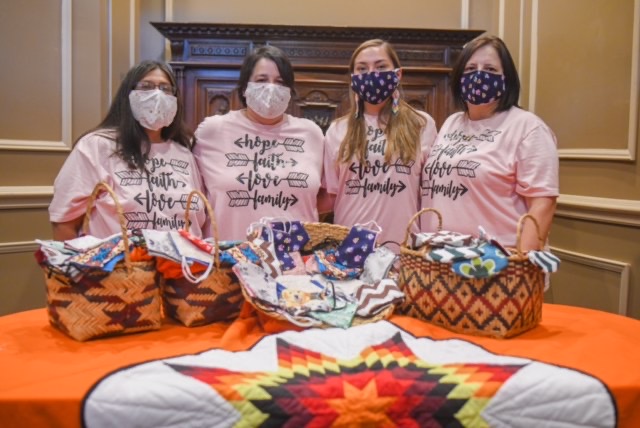
Estas increíbles mujeres hacen este servicio porque han visto morir a muchos de sus seres queridos durante esta pandemia. Como miembros de la tribu, saben que es importante ponerse de pie y retribuir cuando sea necesario.
Agradecen a Dios por los dones y las oportunidades que se les han dado y porque han podido ayudar a otros miembros del Cuerpo de Cristo. También están agradecidos por el Padre Bob Goodyear, quien siempre ha mostrado su amor y apoyo a la gente Choctaw.
“No necesitamos pensar en nosotros mismos; tenemos que pensar en los demás,” compartió Gwendolyn y continuó,” cuando Tina y Michelle me pidieron ayuda, pensé en mi propia madre y en cómo quisiera que ella estuviera protegida y en cómo quiero que otros miembros de la tribu también estén protegidos.” Gwendolyn le da crédito a sus abuelos, que eran diáconos, por su forma de pensar.
Kaylee, una estudiante de último año de la Universidad del Sur de Mississippi (USM), compartió su razón para ser parte de este proyecto, “Vi la necesidad de máscaras en mi comunidad, especialmente para nuestros mayores, y en lugar de simplemente sentarme todo el día, lo cual es lo que estaba haciendo una vez que terminó la escuela, elegí hacer algo productivo que pudiera beneficiar a mi gente. Veo a nuestros mayores como maestros para mi gente; por lo tanto, cualquier cosa que pudiera hacer para proteger su salud, estaba más que dispuesta a hacerlo.”
Tina, Michelle y Kaylee son católicas, y Gwendolyn es bautista. Bromean sobre cómo no sostienen este hecho en contra de ella. Es algo hermoso cuando las personas pueden unirse por una gran causa. Se centran en su objetivo común: querer servir a otros a su alrededor.
Durante estos tiempos de división, es maravilloso ver la unidad en el trabajo. Estas mujeres realmente viven 1 Pedro 4:10: “Como buenos administradores de los diferentes dones de Dios, cada uno de ustedes sirva a los demás según lo que haya recibido.”
Michelle, Gwendolyn y Tina compraron gran parte del material utilizando sus propios fondos, pero también han recibido donaciones de otros, incluso de personas fuera del estado. Esta positiva retroalimentación realmente sorprendió y motivó aún más a estas mujeres y han apreciado toda la generosidad. Siempre aceptan donaciones para continuar con el esfuerzo de mantener a otros seguros, por lo que, si usted desea donar material como tela, hilo o elástico, envíe un correo electrónico a daisey.martinez@jacksondiocese.org.
La Tribu de Indios Choctaw de Mississippi es la única tribu de indios americanos reconocida federalmente que vive dentro del estado de Mississippi. Si desea obtener más información, visite Choctaw.org.
Fe en acción – Santa Ana, Cartago
Por Dorothy Balser
CARTHAGE – El padre Odel Medina y Edgar Morales, uno de los voluntarios de la parroquia, hablan con Dorothy Balser sobre cómo vive la Iglesia Católica de Santa Ana en Cartago el llamado de su fe en nombre de “estos hermanos míos más humildes.” (Mateo 25:40)
P: ¿Qué significa para usted personalmente poner su fe en acción?
Edgar: Primero, gracias a Dios por todo lo que he recibido de él. Estamos felices porque muchas personas nos están ayudando. Lo que tenemos es fe para ayudar a los demás. Gracias a Dios somos miembros de la iglesia y la iglesia nos está enseñando cómo podemos ayudar a los demás. Hasta hace cuatro años, no estaba muy cerca de la iglesia. Después que comencé a venir a la iglesia con más frecuencia, me invitaron a estar en un grupo. Tenemos algo así como un consejo parroquial en nuestra iglesia llamado Directiva. Todos los años tienen elecciones. Cuando llegaron las elecciones, la gente me eligió presidente. Estaba muy sorprendido y al principio tenía miedo. “¿Por qué me eligieron?” Pero doy gracias por esa experiencia. He crecido de una manera profundamente espiritual.
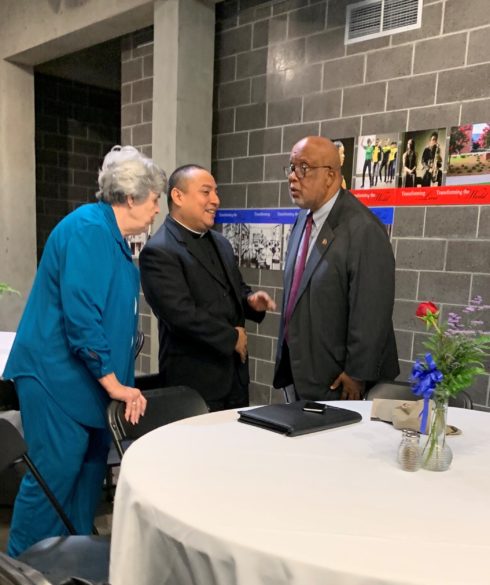
P: En general, ¿cómo muestra Santa Ana la fe en acción?
Padre Odel: Creo que estamos en un momento para estar conscientes de Dios. Piensas que crees, tienes que mostrar cómo vives tu vida. La gente ya sabe que tu fe debe estar en acción. Intentan ayudarse mutuamente. Si pueden hacerlo solos, lo harán. Pero si es algo más grande, la comunidad coordinará más Tenemos muchos casos diferentes y la mayor experiencia fue el año pasado con las redadas. No solo los hispanos sino también los feligreses de habla inglesa respondieron. Y ahora, durante esta pandemia, todos intentamos ayudar a las personas que contrajeron el virus, miembros de la parroquia o no, su fe los movió a ayudar a cualquier persona enferma al traer cosas a su puerta. Fui testigo, también sufrí el virus y fue sorprendente lo mucho que se preocuparon por mí.
P: Describa uno o dos de los ministerios en Santa Ana donde se ve la fe en acción.
Edgar: El Ministerio de Ayuda Hispana comenzó con las redadas. La ayuda llegó y el padre Odel me llamó para formar parte del equipo. No teníamos la experiencia para ser un comité o para distribuir la ayuda que recibíamos. Gracias al Padre Odel pudimos organizarnos para usar la ayuda que recibíamos para proporcionar esta ayuda. Al principio, pensamos que nadie de afuera quería ayudarnos. Pero me he dado cuenta, gracias a Dios, que hay muchas personas que se preocupan por lo que estamos haciendo. Aunque somos migrantes, las personas nos están ayudando y podemos ayudar a las personas con el alquiler, las facturas de servicios públicos y los alimentos para su mesa. Yo mismo soy migrante y no sé qué pasará mañana, así que pude ayudar de inmediato.
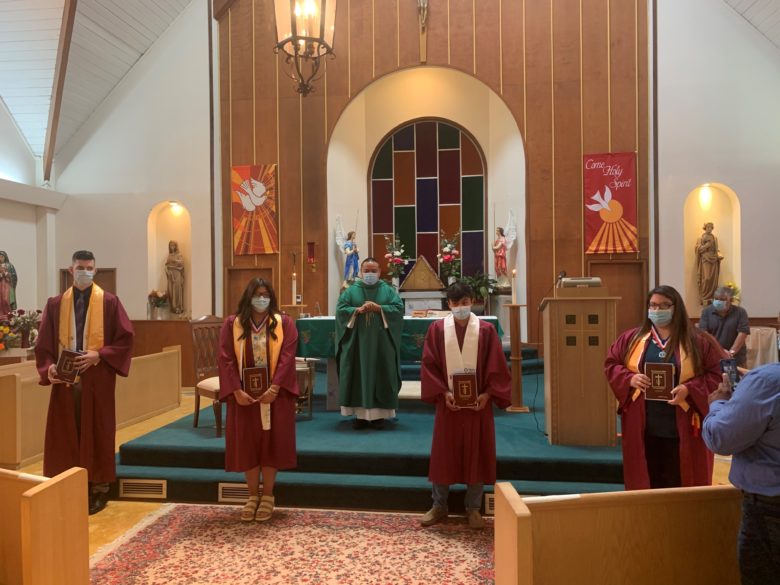
P: ¿Qué impacto ha tenido, este ministerio de fe, en la acción de las personas servidas y en las personas involucradas en el ministerio?
Padre Odel: Las personas que sirven se han vuelto más conscientes de cómo poner su fe en acción. Esta crisis los ha hecho más conscientes, más activos y generosos con sus vidas. La primera persona que respondió para ayudar a las personas afectadas por las redadas fue uno de los afectados por la incursión de ICE. Él vino a mí y me dijo que “…a pesar de que estábamos afectados, tenemos que hacer algo.” En lugar de sentir pena por ellos mismos, se acercaron para ayudar a los demás. Las personas que han sido atendidas se sienten menos aisladas. La iglesia ha sido como un oasis para ellos. Saben que la iglesia es solidaria. Ayudar a la gente ha hecho que la iglesia sea más creíble.
P: ¿Qué desafíos ha enfrentado en el desarrollo de este ministerio y qué lo mantuvo a pesar de los desafíos?
Padre Odel: El ministerio comenzó en medio de una crisis, una incursión migratoria, y esto trajo mucho miedo, dolor y tristeza, por lo que el desafío era responder en tiempos de crisis, para las personas, la iglesia era el único refugio donde podrían sentirse seguros. Gracias a la ayuda de muchas personas en todo el país, se pudo ayudar a las familias.
Lo que nos ha mantenido a pesar de los desafíos es la palabra de Dios que nos dice que él siempre estará con nosotros. Además, el apoyo se podría decir a nivel nacional para este ministerio, en términos económicos.
P: ¿Qué sugerencias tiene para las personas, o parroquias, que no están seguros de cómo poner su fe en acción?
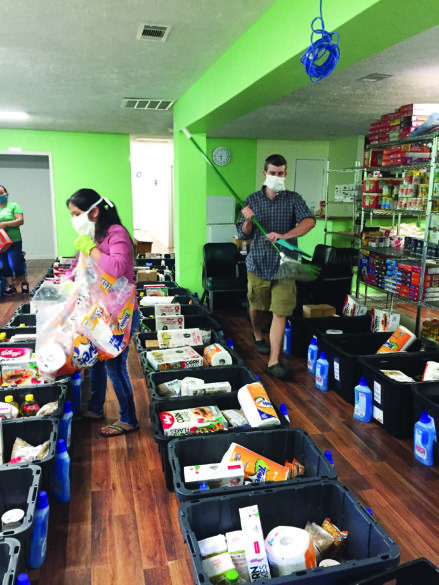
Padre Odel: Primero, como dice Santiago, la fe sin obras es una fe muerta (Santiago 2:14-26). Tener fe, orar, hablar con Dios te llevará a la acción, el fruto de la oración. Entonces, escucha lo que Dios te está diciendo y pidiendo. Y no tengas miedo cuando te dé los regalos.
Father Nguyen, Father Sánchez ordained for the diocese
By Berta Mexidor and Joanna Puddister King
JACKSON – Bishop Joseph Kopacz ordained César Sánchez Fermín and Andrew Nguyen to the priesthood at the Cathedral of St. Peter Jackson on Saturday, June 27.
Though the COVID-19 pandemic delayed the celebration originally scheduled in May, it could not stop the celebration of the two men joining the priesthood, but the event looked slightly different due to safety regulations in place. Every other pew was blocked off to allow for social distancing and members of the diocese were encouraged to watch via Facebook live rather than attend in person. Diocesan priests, seminarians, and a few selected special guests of the men to be ordained wore masks throughout the service.
“The Lord has blessed our diocese with holy men from every corner of the earth. Welcome Father Andrew and Father Cesar!” commented Mark Beyea of Clinton, on Facebook. The spirit of gratitude and happiness could not be stolen from the occasion by the pandemic.
The ordination Mass also celebrated the cultural diversity of the diocese , the Vietnamese heritage of now Father Nguyen and the Spanish heritage of now Father Sanchez, who hails from Michoacán, Mexico.
Beginning his homily, Bishop Kopacz mentioned the universal church and how that all “gathered around the Word of God as proclaimed so beautifully and profoundly in Spanish, Vietnamese and in English” for the ordination Mass. He also acknowledged the reach of livestreaming the event, which reached family and friends of now Father Sanchez in Michoacán, Mexico and now Father Nguyen in Ninh Thuân province and Ho Chi Minh city in Vietnam.
The ordination Mass included many powerful moments, especially when the men lay prostrate in an act of humble prayer and surrender before the altar invoking the prayers of the saints sung in chant by Father Aaron Williams and seminarians Andrew Bowden and Tristan Stovall.
After the laying on of hands and prayer of ordination, the ordination of the two new priests proceeded to their investiture of the stole and chasuble. Father Nguyen was vested by Father Peter Hoai Thanh and Father Sánchez was vested by Father Mike O’Brien of Sacred Heart Canton.
Fathers Andrew and César are following the Good News of the scriptures, and with their ordination, both promised to Bishop Kopacz, to propagate it to continue saving souls.
The happiness of the occasion was shared by all the emojis and comments from the viewers:
Jim McCraw of Jackson wrote “Congratulations Father Andrew! Love your quiet and confident spirit. You will make a difference! Your affection for Meridian is hard to hide.”
“Prayers of thanksgiving for these two young men for answering the call to the priesthood. May the Lord bless them in their service,” wrote Mary P. Robinson of Madison.
After the celebration of the Eucharist, Bishop Kopacz invited Father Sánchez and Father Nguyen to speak to their families who were not able to be present at the joyous event due to the pandemic through the livestream broadcast.
In his native language, Father Sánchez spoke to his family. He closed in English saying that he has had a wonderful support system from those in the Diocese of Jackson and that he has “always felt at home.”
“And you know that home is where your heart is, so I really feel that. Now, Jackson diocese is my second home,” said Father Sánchez.
Father Nguyen spoke to his family members present and afar in Vietnamese and then thanked all for their prayers and support.
In his closing remarks, Bishop Kopacz asked all to “continue to pray for priests … and continue forward together as the Lord’s people.”
Father Sánchez is appointed parochial vicar at St. James Tupelo and St. Christopher Pontotoc.
Father Nguyen is appointed parochial vicar at St. Patrick and St. Joseph parishes in Meridian.
Masked, distanced priests take part in postponed chrism Mass
By Joanna Puddister King
JACKSON – This year’s chrism Mass in the Diocese of Jackson did not take place during Holy Week as usual and instead was celebrated on June 17 with a crowd of socially distanced, masked priests from around the diocese.
The special Mass at the Cathedral of St. Peter Jackson was rescheduled due to churches being closed to the public because of the COVID-19 pandemic, a restriction that continued up until Pentecost on May 31.
“The chrism Mass is a ‘manifestation of the priests’ communion with their Bishop,’ so it is very important for clergy to participate in that Mass even if a congregation of any size may not be able to gather,” explained chancellor, Mary Woodward. “Though not technically close to Easter as we would have wanted, the Mass nonetheless had a great fraternal spirit with the clergy gathering albeit six feet apart in masks. Much care was given to keep the clergy safe and to maintain the integrity of the liturgy.”
Bishop Joseph Kopacz welcomed all clergy present and those watching the live stream presentation on Facebook under the “unusual circumstances of worship.”
The masked and socially distanced Diocesan priests, who joined Bishop Kopacz for the Mass renewed their priestly promises. Bishop Kopacz blessed them and blessed the holy oils to be used in the administration of the sacraments throughout the diocese for the year.
The oil of the sick is blessed to bring the strengthening and healing power of Christ in the sacrament of the anointing of the sick. The oil of catechumens is used at Baptism to purify candidates before baptizing with water. The sacred chrism is used to anoint individuals after baptism, seal those who are to be confirmed with the Holy Spirit, and in holy orders for priests on the hands and bishops on the head. It is also used to anoint altars and churches during their dedication.
During his homily, Bishop Kopacz reflected on the pandemic and how different congregations look now with “people looking back with masks on. Just seeing the eyes.” Even with masks, few congregants and being socially distanced, Bishop Kopacz said that, “it is our way of coming together in spite of all of the obstacles to say that we are the body of Christ.”
The faithful throughout the diocese were invited to take part in the livestreamed Chrism Mass through Facebook Live. After the Mass, priests received their oils and brought back to their parishes.
Meet Tristan Stovall
In preparation for our Homegrown Harvest Gala in the fall, which will benefit the Diocese of Jackson Office of Vocations, over the next several weeks we will feature a Q&A with one of our seminarians. This week, meet Tristan Stovall who is entering his first year of formation.
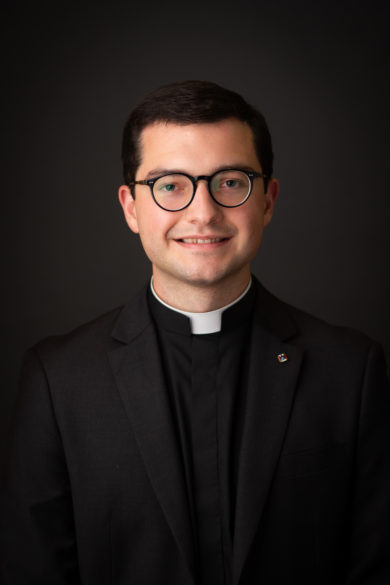
Home parish: Holy Cross Philadelphia
Background: I was born and raised in the red clay hills of Neshoba county.
What is your vocation story? I was raised a Baptist. My first memory of Catholicism is seeing the funeral of Pope St. John Paul II on television. At the time I was awestruck by all the proceedings. I had so many questions about what was happening and who this man was for whom the whole world was coming to a halt. I became more and more interested as I grew up. When I was 15, I went to Mass for the first time at St. Louis Cathedral in New Orleans. I knew then that I had to become a Catholic. At the Easter Vigil in 2014 I was received into full communion with the church.
I have always had a deep desire to dedicate my life entirely to God. This desire was present for as long as I can remember. Entering into the sacramental life of the church changed my life. I began attending daily Mass and frequenting the sacrament of penance.
The example of the saints was very influential in my pursuing a vocation to the priesthood. St. Catherine of Siena has always exercised an influence over me. Seeing her example of total dedication has constantly inspired me to give myself entirely to the service of Jesus Christ and His Bride, the church. I hope one day to receive the call to Holy Orders and to be entirely dedicated to the service of the church.
What draws you to diocesan priesthood?
The care of souls is what draws me to the diocesan priesthood. The care of souls means that the primary responsibility of the diocesan priest is to work for the salvation of those souls who are entrusted to his care. I believe that this is the specific ministry to which the Lord is calling me. This ministry is specific to the diocesan priest. I discerned the religious life for a while, but ultimately came to see that that was not what the Lord was asking me to do.
What are your hobbies/interests?
I enjoy playing the piano. I also very much enjoy reading and traveling.
Who is your favorite saint and why?
My favorite saint is Catherine of Siena. I love her because she has been a friend to me in my discernment. She is a “no-nonsense” sort of person. She was at once extremely joyful and serious. I think St. Catherine represents the divine humor which we so often miss in our faith. This 20-something-year-old, illiterate Italian girl was not afraid to confront the world’s most powerful people in order to carry out Christ’s work. Her life was profoundly ecclesial, she was focused on being faithful and ensuring the unity of the church, for which Christ prayed.
Do you have a favorite devotion?
My favorite devotion is lectio divina, which is the prayerful reading of the Word of God. I am drawn to this devotion because it brings me to a deeper knowledge of Christ.
What is something people might be surprised to learn about you?
I was once part of a Southern rock band.
Who is your favorite sports team?
If my answer to this question was not “the LSU Tigers” my family would disown me.
What has been the most rewarding part of being a seminarian? And the most challenging?
The most rewarding part of being a seminarian has been coming to a deeper knowledge of the faith. To know God is to love Him. I have experienced this concretely in my life throughout my years of seminary formation.
What advice do you have for those discerning a vocation?
Don’t be afraid to give it a try. You have nothing to lose. You can’t discover whether or not you have a vocation until you try it out.
Calendar of events
SPIRITUAL ENRICHMENT
MADISON St. Francis of Assisi, Assisi prayer chain is available to all those in need. Details: Call (601) 850-3432 or (601) 291-4373 between 5-7 p.m.
PARISH, SCHOOL AND FAMILY EVENTS
CLARKSDALE Catholic community of St. Elizabeth, Charismatic prayer group meets Tuesdays at 2 p.m. via Zoom meetings. All parishioners are invited to pray with us from your phone, tablet or computer. Contact the church office to sign up and/or to add your prayer requests. Details: church office (662) 624-4301.
GREENVILLE St. Joseph, Study of the beatitudes, Join Tristan Stovall for study of the beatitudes on Wednesdays in July at 6 p.m. right after 5:30 p.m. Mass. Bring your Bible and a friend, but don’t forget your mask! Details: church office (662) 335-5251.
MAGNOLIA St. James Mission, you are invited to embark on a journey towards faith and racial healing sometime in the first week of Sept. via Zoom meetings. It is an opportunity to further and deepen our desire to follow the way of Jesus. This program is not specifically Catholic. It is universal. All are welcome. The program is not about religion; it is about human dignity and respect. If you are interested, please call or email. Details: Chris Ingrassia (301) 266-0433, gracie_eddie@yahoo.com. Website is: https://justfaith.org/faith-and-racial-healing/.
NATCHEZ St. Mary Basilica, Blood drive, Thursday, July 28 from 1-6 p.m. at the O’Connor Family Life Center. Details: Regina at the church office (601)-445-5616 or schedule your appointment at www.vitalant.org.
YOUTH BRIEFS
GREENVILLE St. Joseph, Limited time online Vacation Bible School for ages 4-12, “The Incredible – Discover How Jesus Saves the World.” Let us help your child and family grow in faith and discover the Incredible Savior, Jesus, through prayer, video and song. You will need to register your family at www.catholicbrain.com using the following information: School name: St. Joseph Catholic Church, Greenville, MS; School code: STJ51097. Please note: the last date of availability is July 25. Details: Mary Ann Barker at (662) 335-5251.
NATCHEZ St. Mary Basilica, The CYO still plans to hold a Garage Sale (date to be determined by COVID). Details: call Carrie Lambert at the church office (601) 445-5616. Please hold onto your donations for the time being and let her know if you have nowhere to store donations.
St. Mary Basilica, St. Mary’s Vanguard (newly formed Young Adult Ministry) will resume its Trivia Night on Tuesday, July 21 at 7 p.m. in the Family Life Center. Cost: $5 to play and $5 for a boxed meal. Babysitting provided. Prizes for the winner(s). Details: church office (601)-445-5616.
SAVE THE DATE
JACKSON St. Richard School, Save the date Friday, Feb. 12, 2021, Krewe de Cardinal. Details: church office (662) 256-8392.
NATIONAL Virtual 2020 Catholic Immigrant Integration Initiative, Oct. 1-2. The CIII seeks to understand, expand and strengthen the work of Catholic institutions with immigrant communities. Registration will open soon. To receive updates about registration, please fill out this form: https://forms.gle/4gX2XS3enWoP9vAp9. Details: For details about the virtual conference visit https://cmsny.org/event/2020-catholic-immigrant-integration-initiative/
LIVE STREAMING
In person Masses are now open at many parishes within the Diocese of Jackson. Check with your local parish for details and follow guidelines in place for attendance.
Some parishes are still offering live streaming options via Facebook live and YouTube to be present to their faith communities and bring Mass to the faithful.
The obligation to attend Mass continues to be dispensed, so if you do not feel safe attending, or have an underlying health condition, or feel sick, please stay hope. Be safe and stay vigilant!

#MaskUpMississippi
St. Dominic Health Services Marks One Year Since Joining Franciscan Missionaries of Our Lady Health System
By Grace Weber
JACKSON – July 1, 2020, marks the one-year anniversary of St. Dominic Health Services joining the Franciscan Missionaries of Our Lady Health System. This time last year, the Franciscan Missionaries of Our Lady, who are the sponsors of the Franciscan Missionaries of Our Lady Health System (FMOLHS) headquartered in Baton Rouge, Louisiana, completed a transition of sponsorship from the Dominican Sisters for St. Dominic Health Services which is the only Catholic healthcare facility in Mississippi. With the completion of the transfer, St. Dominic’s became the seventh regional center, and first in Mississippi, served by FMOLHS which has grown to include other facilities since then.
Prayer and patron saints have always played an important role in Catholic healthcare. Fittingly, in the early 13th century, St. Francis and St. Dominic who were the two patrons of FMOLHS and St. Dominic’s sponsorships, respectively, are believed to have met while in Rome for the Fourth Lateran Council. The two men quickly developed a close bond enriched by their common goal of founding their orders, despite the many obstacles they both faced. In tribute to their inspired friendship, for the last year a specially written prayer titled Companions on the Journey has been used to guide today’s organizations’ integration into a single system ministry. Together, the Health System is faithfully serving those most in need in both Louisiana and Mississippi.
“I look back over the past year and am inspired by what’s been accomplished across our entire health system. We welcomed St. Dominic’s into our System ministry with the mindset of collaboration and learning from one another as we are together sustaining and growing the healing mission of Catholic healthcare in Mississippi. Today, St. Dominic’s remains an important beacon of hope and healing as our communities face the incredible challenge of COVID-19 and the local impact of a global pandemic,” said Dr. Richard Vath, president and CEO of FMOLHS. “St. Dominic’s ministry had been an asset to the Jackson community for more than 70 years, and one in which we all look forward to continuing to serve for generations to come.”
“Over the last year, we have experienced firsthand the blessing of being part of the Franciscan Missionaries of Our Lady Health System and the benefit especially to our patients and community,” said Lester Diamond, president of St. Dominic’s. “With the help and support of FMOLHS, St. Dominic’s is making important and timely progress as today’s healthcare industry continues to rapidly evolve. Despite industry change, our commitment and care for the families of Mississippi is unwavering. None of us could have predicted the impact of the COVID-19 pandemic and now our response as a strong and integrated health system assures St. Dominic’s legacy of high-quality, compassionate healthcare is protected for the people of Mississippi.”
Since the transition last July, the Franciscan Missionaries of Our Lady Health System opened the freestanding Our Lady of the Lake Children’s Hospital in Baton Rouge, Louisiana, and welcomed Our Lady of Lourdes Heart Hospital in Lafayette, Louisiana.
Springfield Dominican Sisters take the struggle for equity to Wall Street
By Sister Beth Murphy, OP
SPRINGFIELD, Ill. – On the fifth anniversary of the publication of Laudato Si’, the Dominican Sisters of Springfield announced their participation in Dominican Sisters Climate Solution Movement, a strategic green investment initiative to address climate change and its effects on marginalized communities disproportionately impacted by global warming.
Sixteen Dominican Sisters’ congregations have committed $46.65 million to the initiative, in partnership with Morgan Stanley, to seed climate solutions funds that have attracted more than $130 million in capital investments.
“Dominicans have long been engaged in addressing issues related to poverty and Earth’s degradation,” the sisters said in a joint statement. “Today we are extending these efforts to Wall Street by proactively investing in marketplace climate solutions that we hope will have a catalyzing impact for the common good of people and planet.”
“We are bringing these resources to the marketplace to help address our deep concern about the integrity of God’s creation and the people most impacted by climate change,” said Sister Rebecca Ann Gemma, the prioress general of the Springfield Dominican Sisters. “Although we initiated this effort well before the outbreak of COVID-19 — well before this long-overdue national awakening to race-related police violence — the global pandemic and the racial inequity it has exposed underscore the link between climate change, ecological degradation, and the health and well-being of people, especially those most vulnerable.”
Leaders of the participating congregations of Dominican Sisters, representing nearly 3,500 Catholic sisters from across the nation, are participating in this collaborative initiative in partnership with the Chicago office of Graystone Consulting Group, a women-led institutional consulting practice which is part of Morgan Stanley. The Dominican’s anchor investments in this initiative have attracted additional investors, providing a pool of more than $130 million for investment in climate solutions that integrate the UN’s Sustainable Development Goals on water, sanitation, food security, energy, and related challenges facing economically impoverished communities.
The initiative, five years in the making, has attracted numerous investors. Séamus P. Finn, OMI, Chief of Faith Consistent Investing of the Oblate International Pastoral (OIP) Investment Trust, said, “The OIP Trust is excited by the opportunity to join the Dominican climate fund and was especially attracted by the insight and innovation that is at the core of the fund’s approach. The vision for the fund is grounded in the transformation of the current financial system and gives priority to people, planet, and sustainability.”
Sister Rebecca Ann said, “We are delighted that this integrated approach to climate investing has attracted other investors and investment managers, helping to scale this kind of approach to climate finance globally.”
The unusual partnership between U.S. Dominican Sisters and a global Wall Street investment firm emerged from a commitment the Dominican Sisters made together in 2015 to develop an appropriate strategy to promote investment in climate solutions.
A Sisters’ Climate Finance Taskforce was formed, reaching out to more than three dozen financial institutions in search of a manager that would develop financial products addressing climate change and integrating the UN Sustainable Development Goals. “We found that manager in the Graystone Consulting Group of Morgan Stanley,” said Caldwell Dominican Sister Patricia Daly, OP, a longtime corporate-responsibility advocate, who played a leading role on the taskforce and in forging the partnership. “This marks a new moment of collaboration in the world of finance. May this milestone spark a new movement of integrated climate solutions that are responsive to Pope Francis’ moral call to humanity in Laudato Si’ to care for God’s creation and God’s people,” she said.
Two years ago, on June 18, 2018, leaders of the 16 congregations gathered at the global headquarters of Morgan Stanley on Times Square to celebrate the inauguration of the initiative with their anchor commitments.
“Partnering with Morgan Stanley’s Graystone Consulting, we seek to identify models for faith-based organizations and other institutions and individuals to proactively invest in climate solutions that will help our world shift to a renewables-based economy while assisting the neediest communities around the globe,” Sister Rebecca Ann said. “We want to do all we can to protect Earth, our common home, and help safeguard the future for young people today and for generations to come.”
The sisters note that their integrated approach to climate finance echoes the call Pope Francis issued in Laudato Si’ for “an integrated approach to combating poverty, restoring dignity to the underprivileged, and at the same time protecting nature.” (139) The initiative is aligned with efforts that Catholic sisters around the world have undertaken for years to address issues related to poverty and ecological degradation. These include support for affordable housing and healthcare, education, micro enterprise, community development, as well as clean water, land conservation, renewable energy, Earth literacy programs, wetlands restoration, and advocacy for climate agreements and programs serving people with low incomes, among others.
Virtual race nets Oxford food pantry donation
By Gene Buglewicz
OXFORD – In March 2020, all races for the Oxford Spring and Summer running season were cancelled due to the COVID-19 pandemic. The Oxford Running Club, which coordinates competitive races in the Oxford/Lafayette area, and at the recommendation of Mathew Zerangue, Assistant Grand Knight, Knights of Columbus Council 10901, St. John Oxford, opted to sponsor a partial “virtual marathon” where runners would run on their own but as a team of four other runners, and submit their times on a social media platform. Thus, the first annual Ox-Mar Marathon Relay was born.
Rather than having runners compete all at one time, and violate the social distancing guidelines, team runners would run as a five-person marathon relay. Each individual in a team would run 5.25 miles and individually report their times on-line. Each of the five – 5.25 mile loops started and ended on the Oxford Square and could be run at any time during a scheduled race period.
The Ox-Mar runners ran their individual legs of the race between May 9 and May 16. Times reported on-line and team scores were added together for the composite team Marathon times.
All eight teams completed the Marathon and posted their times. The First Ox-Mar Marathon Relay was completed despite the virus and rules consistent with social distancing. The result, without a crowd at the finish line or the fellowship of a group, long run, or even a trophy for the winners, a $350 check was presented to the Oxford Food Pantry on May 21.


